Last summer Deb and I enjoyed a day on Bonaventure Island, four kilometres off the tip of the Gaspé Peninsula near the quaint little town of Percé, Quebec. The purpose of the trip to Bonaventure Island was to photograph the Northern Gannet, a large pelagic bird that for years has made Bonaventure Island the largest nesting site in the world for Gannets. With just over 52,000 nests (2012) among five colonies on the island, there are approximately 150,000 gannets on Bonaventure Island from mid-June to mid-September each year. This was actually the second summer that we travelled to Percé hoping to photograph the Gannets. On our first trip we were met with three days of high winds and heavy rains that created seas so rough that the boats could not leave the harbour for the short trip to Bonaventure Island. We were thankful to have perfect conditions on our second annual attempt!
The land masses of Bonaventure Island and Percé Rock were amalgamated in 1985 to become The Bonaventure Island and Percé Rock National Park. The island is also designated as a Migratory Bird Sanctuary. Access to Bonaventure Island is via ferry from the main dock in Percé, which is one of the most beautiful spots in Eastern Canada offering spectacular views of Percé Rock and Bonaventure Island. If you arrive early enough in the morning, you can purchase a $20 ticket to join the first ferry of the day which transports park staff to the island. It is a direct, 20 minute trip providing first access to the island and the 2km hike across the island to reach the Gannet colonies on the far side of the island. The regular ferry is $35 and takes an hour however you travel around Percé Rock and the far side of Bonaventure Island allowing you to see the Gannet colonies on the 300′ cliffs of the island. Deb and I were the only photographers on the staff ferry so the lead time allowed us to enjoy about 90 minutes alone at the Gannet colonies before the tourists and other photographers arrived.
Having the whole day set aside to spend on Bonaventure Island enabled us to plan for many different types of shots including some video. Although we probably took too much gear with us, we used it all and were thankful we made the effort to lug it across the island. Our gear for the day included a Kata backpack filled with a Canon 5D Mk III plus 16-35mm, 24-105mm and 100-400mm lenses as well as a Fuji X-E2 body, 8mm fisheye and 18-55mm lenses. Attached to the backpack was a Gitzo traveller tripod with Markins ball head. Balanced on my shoulder was a Canon 1Dx and 500mm telephoto lens attached to a Jobu carbon fibre monopod and gimbal head. It took about 45 minutes via the shortest trail to reach the Gannet colonies. It was a great hike on a well travelled path cutting directly across the island starting at sea level and rising to about 300′ over the 2km walk.
The hike is mostly in heavy forest and as we approached the far side of the island the scents and sounds of the Gannets greeted us long before the actual birds did. Both the smell and the sound were like nothing Deb & I had experienced before however we quickly acclimatized to both!
The Northern Gannet’s behaviour is quite paradoxical and some of these ironies will be highlighted throughout this post. I think this great pelagic bird is best summed up by Lucie Lagueux, a world renowned expert on the Gannet, who states “What surprises me most about the gannet is its overwhelming ambivalence. Although it is a sea bird, perfectly adapted to life in a marine environment, it spends more than six months on dry land. While its anatomy and behaviour make it eminently suited to cliff-nesting, it does not seem to be able to resist the temptation of the plateau. The gannet is a territorial bird, yet it lives in a very dense colony. It is an aggressive bird, yet its aggressiveness has but one goal: to ensure proximity to other gannets. Finally it is a very predictable bird – in most cases, the gannet’s reaction to a given situation can be easily anticipated. Yet sometimes it exhibits behaviour which is quite inexplicable”. This perfectly describes our observations of the Gannets during the time we spent with them.
When arriving at the colonies for the first time one is astounded by the sheer number of birds. It is difficult to appreciate what 100,000+ birds looks, sounds and smell like and although these images won’t do any of them justice, perhaps this video will help!
The density of the colony is shown below and its remarkable that Gannets returning from fishing excursions can find the exact location of their nest, however they always do. To put the density into perspective, the typical nesting site is 75 cm in diameter and adjacent nesting sites measure 80 cm centre to centre. Nest density is 2.3 nests per square metre.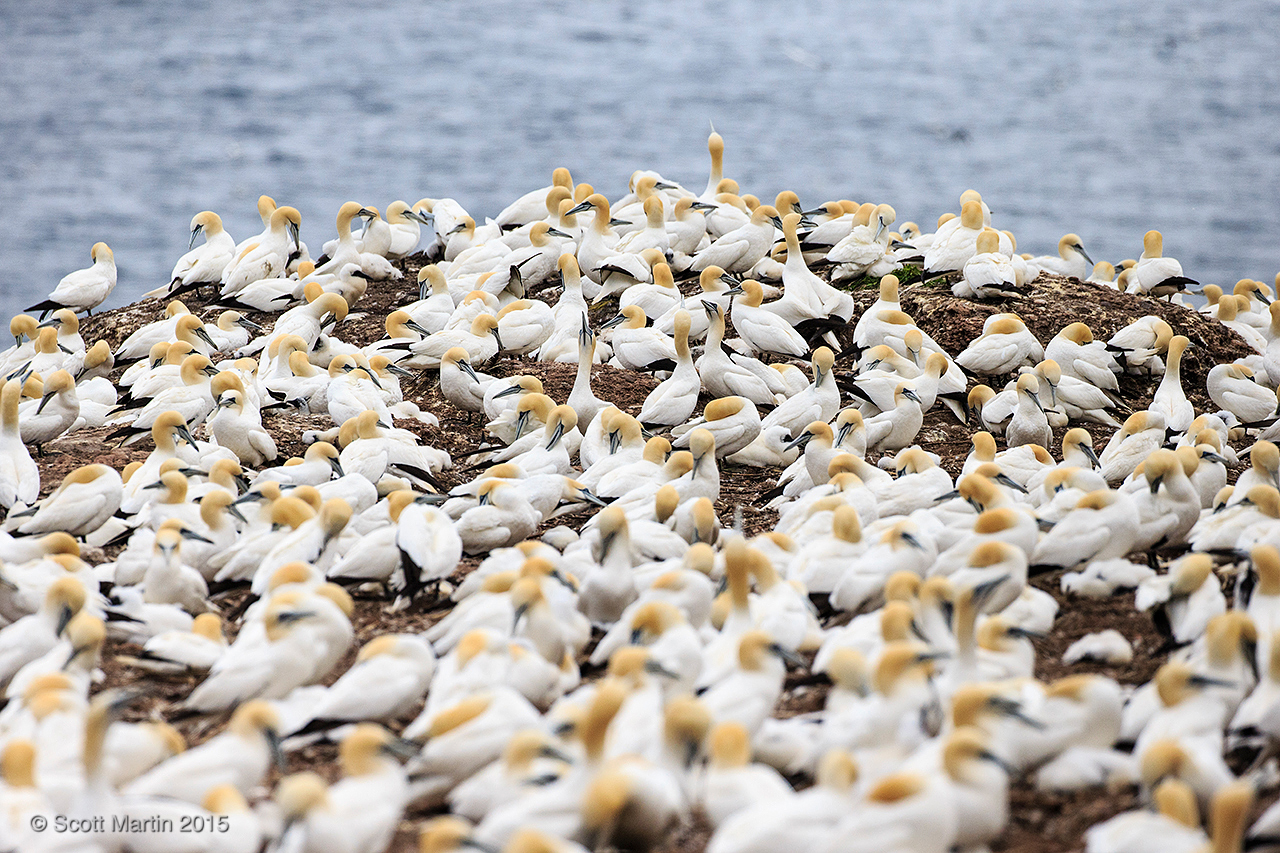
Finding the right nest is a challenge for the Gannet and you can in this next image the reception that the landing Gannet receives from its neighbours.
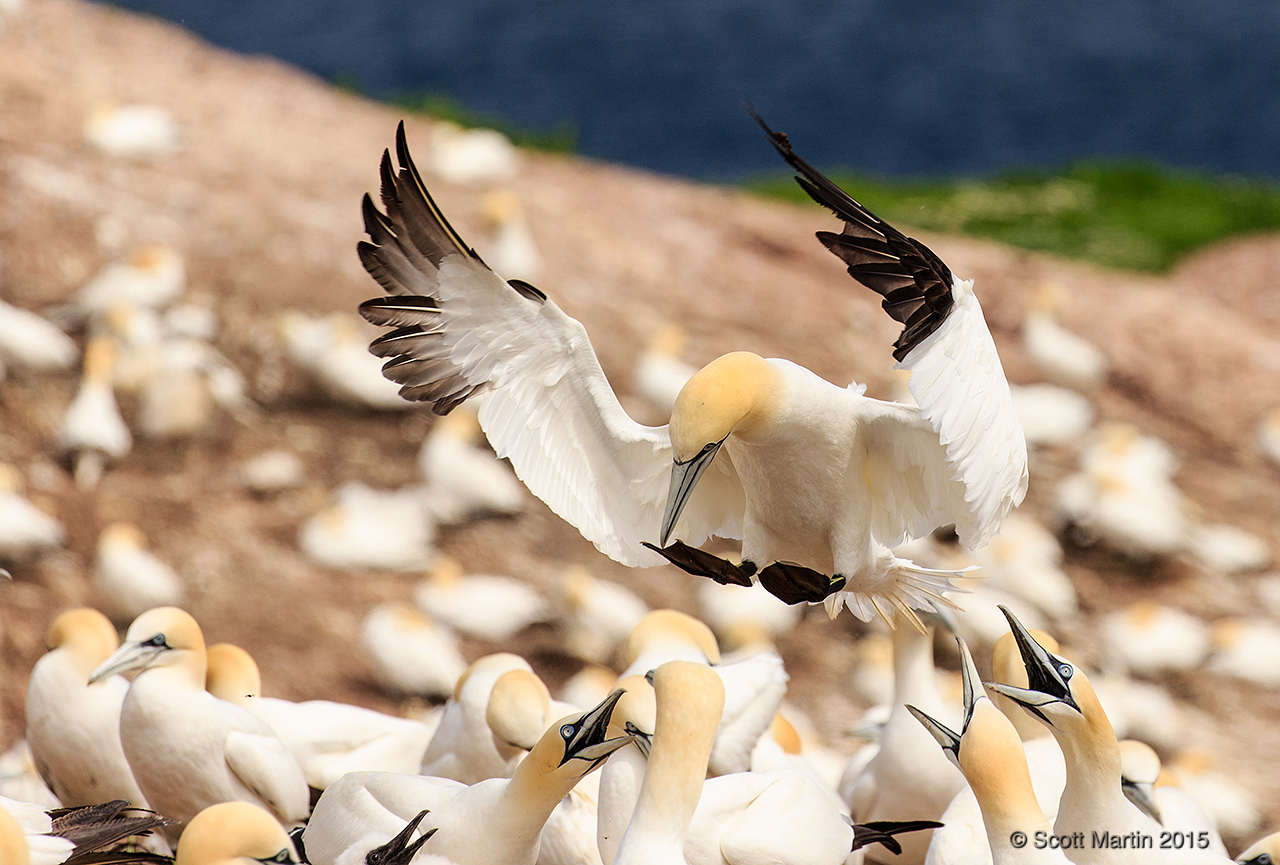
The Northern Gannet is a large pelagic bird weighing on average 3.2 kg with a wing span of 1.8m. Gannets have average lifespans of twenty years however have been known to live for as long as forty. It is a beautiful bird, especially in breeding plumage when the head and crown take on a warm golden hue and the feet are accented with bold green lines.
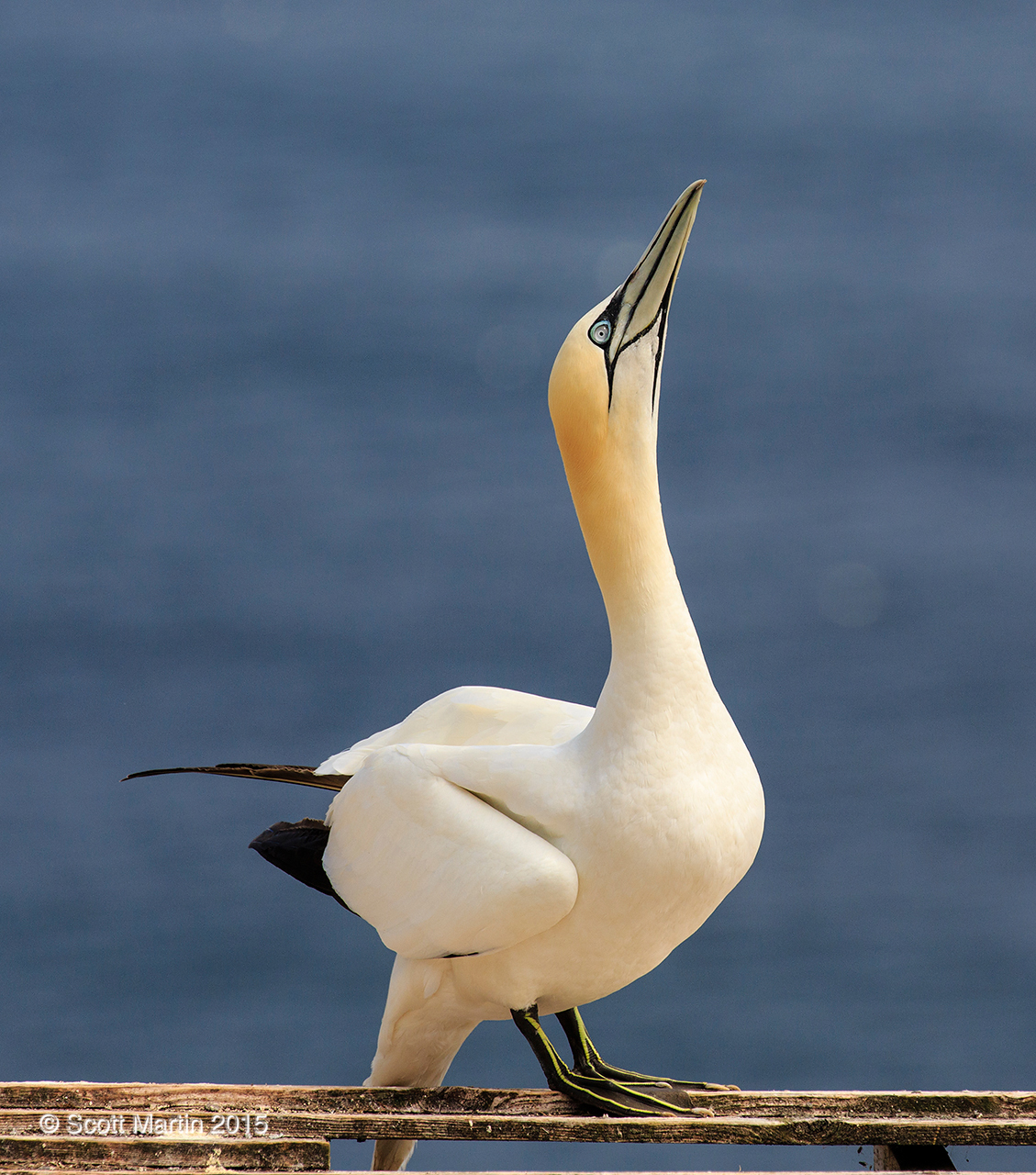
Gannets are also beautiful in flight and their large wing span and thin wings make them excellent gliders. The white underside of the gannet also provides them great camouflage while hunting.
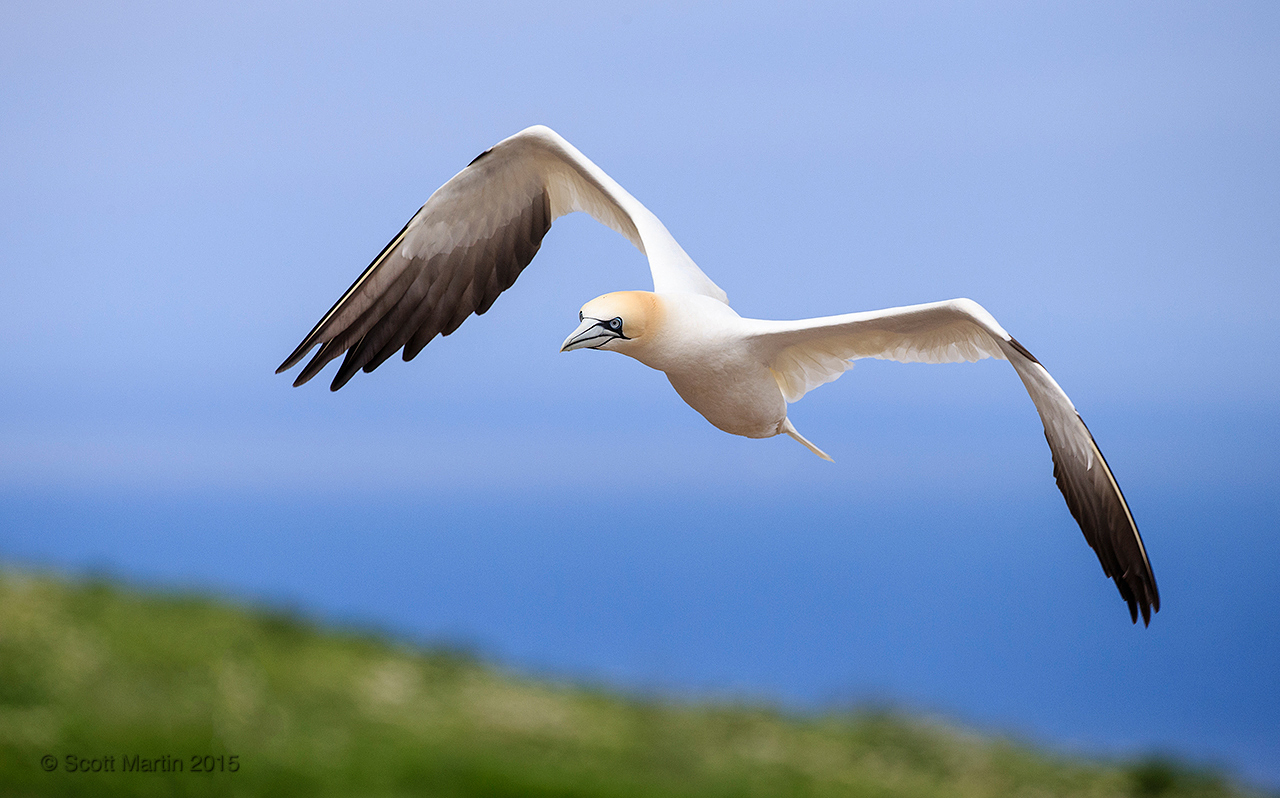
Nests are manicured mounds on the ground that are very sparse yet well defined as seen below. The highly territorial Gannet defends the nest fiercely even though they are very close to their neighbours.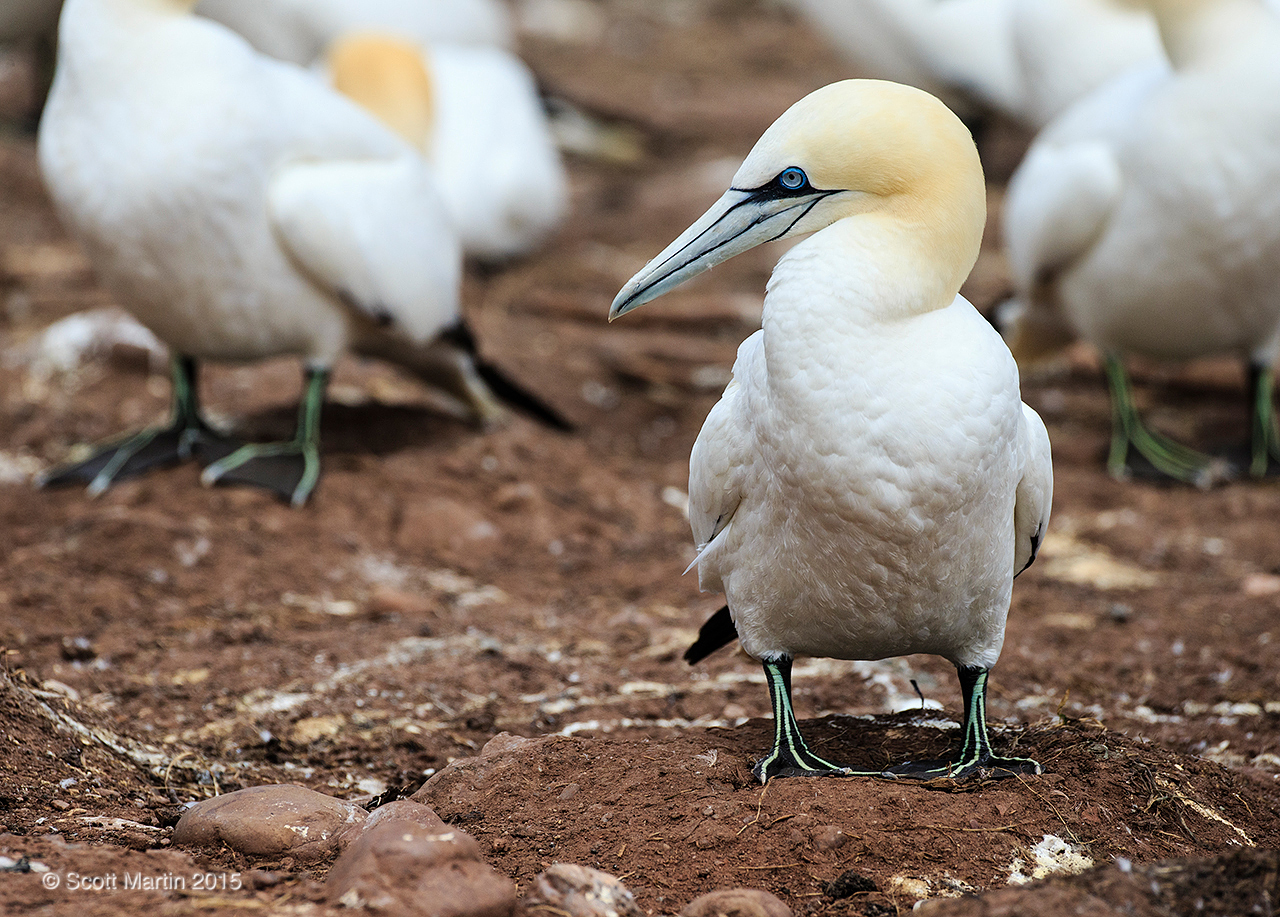
The female Gannet easily lays a single egg as egg size is small compared to the size of the adult bird. Incubation lasts approximately 43 days during which the egg is surrounded by the webbed feet of the parent who’s increased blood flow to the feet keeps the egg warm.
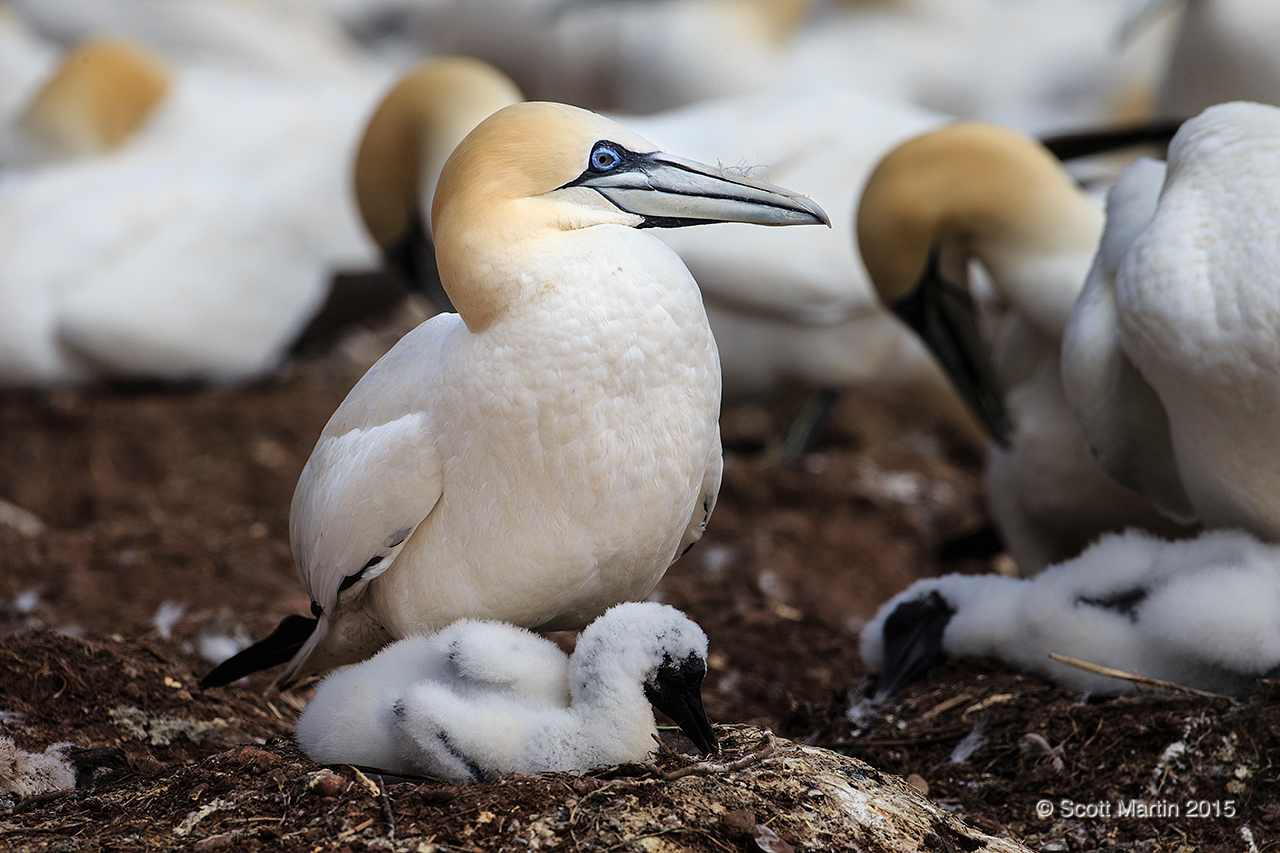
Parents take turns between guarding their chick and fishing to provide food for the newest family member. They transfer partially digested fish to the young bird and it grows rapidly for the 75 days before it fledges.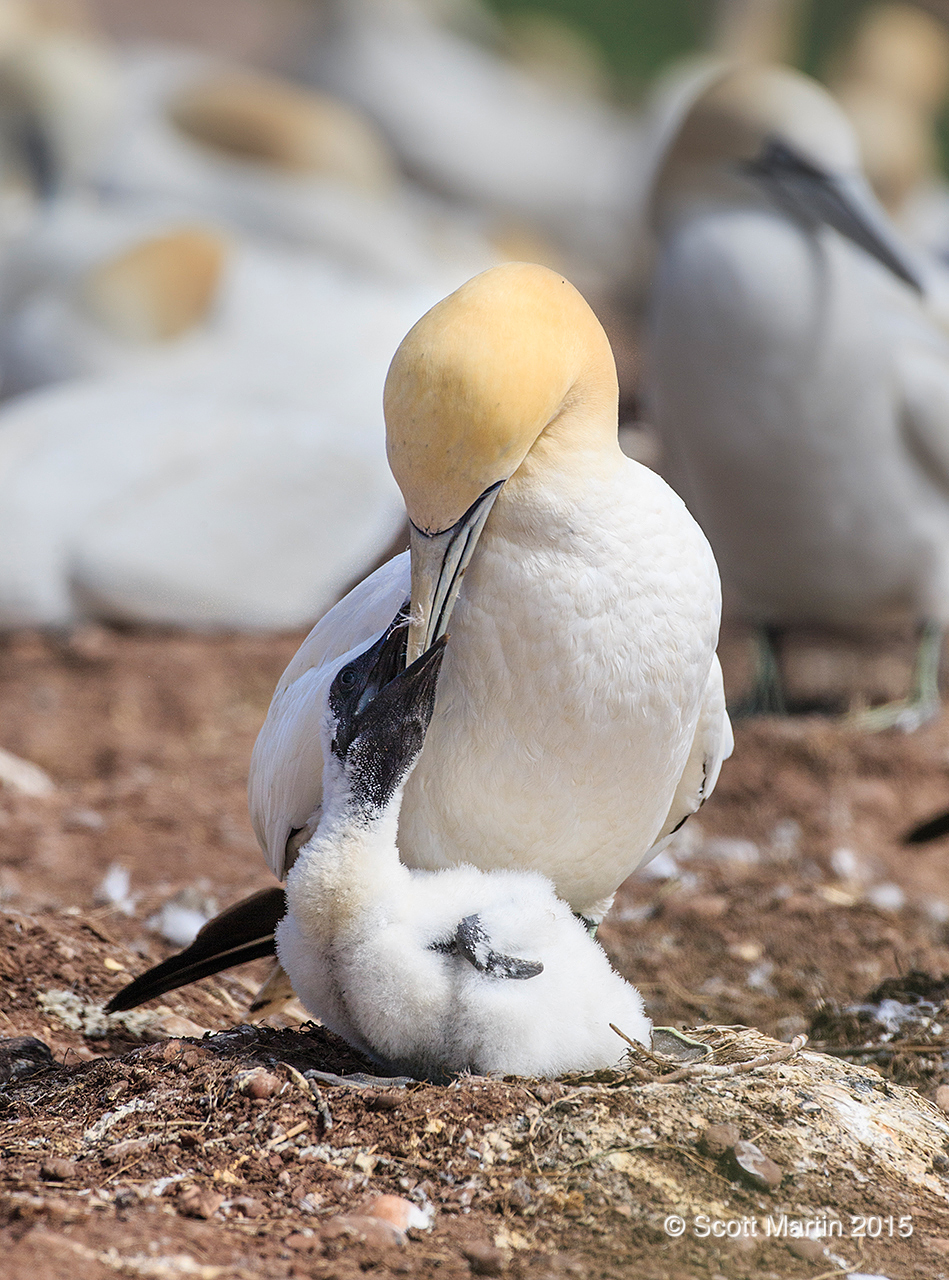
Young birds remain on the nest until they fledge. As they expend little energy while confined to the nest and are continually being fed they actually grow to become larger and heavier than their parents. In fact they weigh almost 1 kg more than the adults when they leave the nest at 10-12 weeks of age. When they fledge they leave the nest and their parents for good and are on their own from that day until they mate at five years of age (younger birds will return to a colony at the age of two or three, but remain at the periphery of the colony and do not pair up or nest until age five). It is quite humorous to see a large young Gannet with its significantly smaller parents just before fledging.
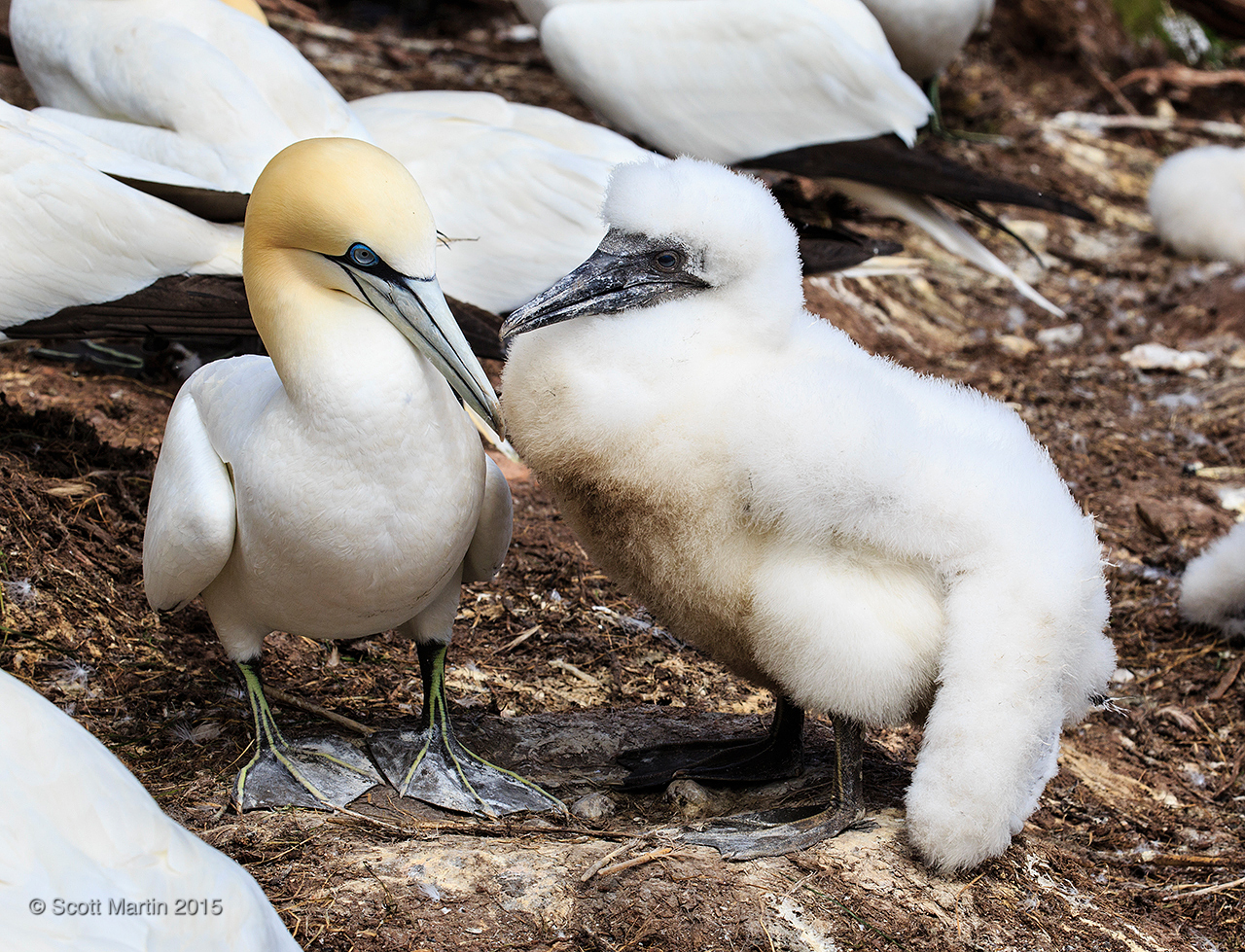
New born Gannets can not be left unattended by its parents as neighbouring Gannets will attack them and should a young bird move off the nest it will surely be destroyed. This is one reason, the first year mortality rate of Gannets is over 60%. This next image shows the fate of a young bird that has inadvertently moved off its nest while its parent vainly tries to come to the rescue. You can see the remains of another chick in the foreground….a poignant visual display of life and death on a Gannet colony. When Gannets lose an egg or young chick they will often lay a second egg and have a second brood during the breeding season. For this reason you can concurrently observe chicks of all different sizes and stages of development within the colony.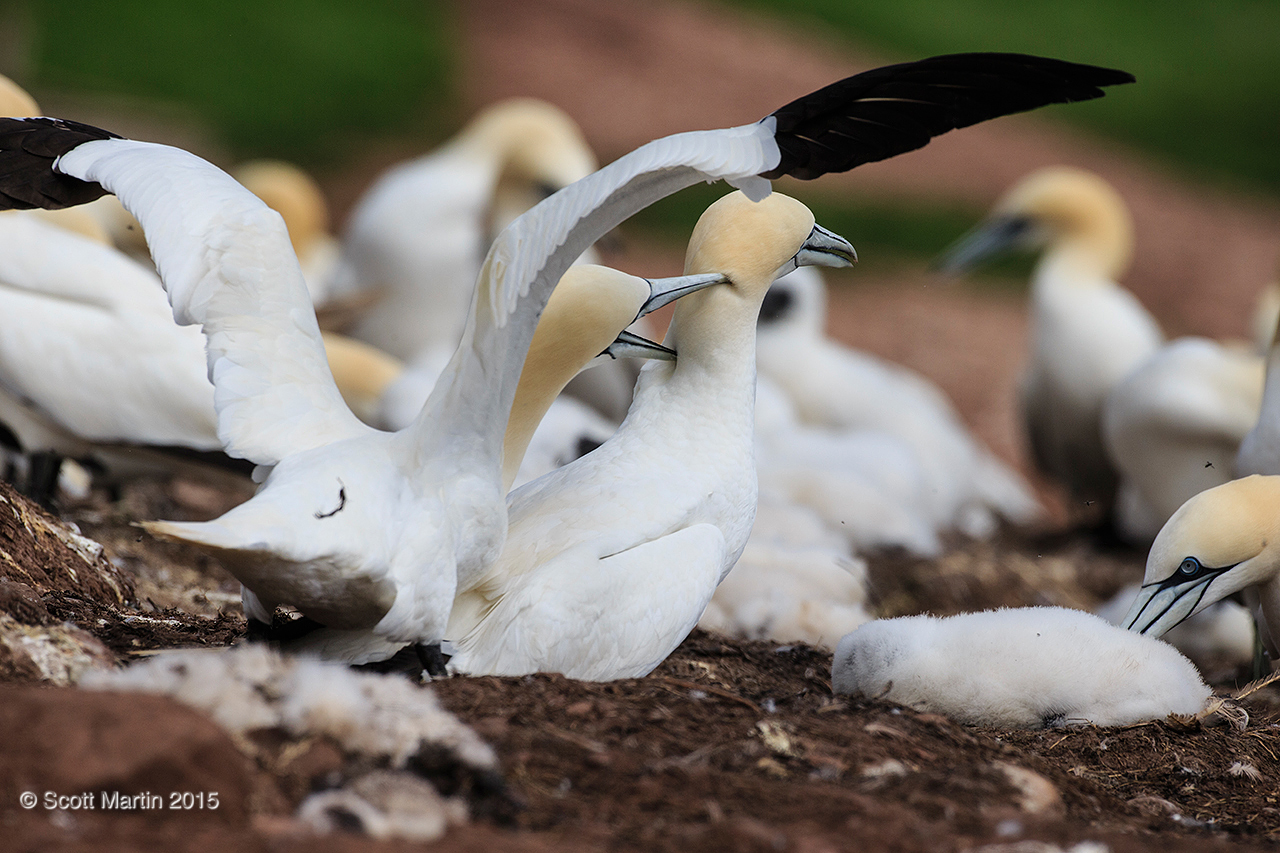
Gannet behaviour is unique and fascinating to observe. The high density of birds in the colony make communication a survival necessity and the Gannets do so through tactile, visual and auditory channels. Gannet behavioural displays provide interesting photo opportunities for the bird photographer. I would highly recommend before travelling to Bonaventure Island that you take time to study Northern Gannets and familiarize yourself with their behaviour. This will allow you to better recognize what is unfolding in the colony and help you compose and capture the signature Gannet behaviours.
Fencing is perhaps the most easily recognized behaviour and is an important mating ritual. Gannet pairs extend their necks with beaks pointed skyward and delicately touch their bills together in a fencing motion. This activity always takes place at the nesting site. Fencing provides an excellent opportunity for that classic Gannet shot as shown in these next images.
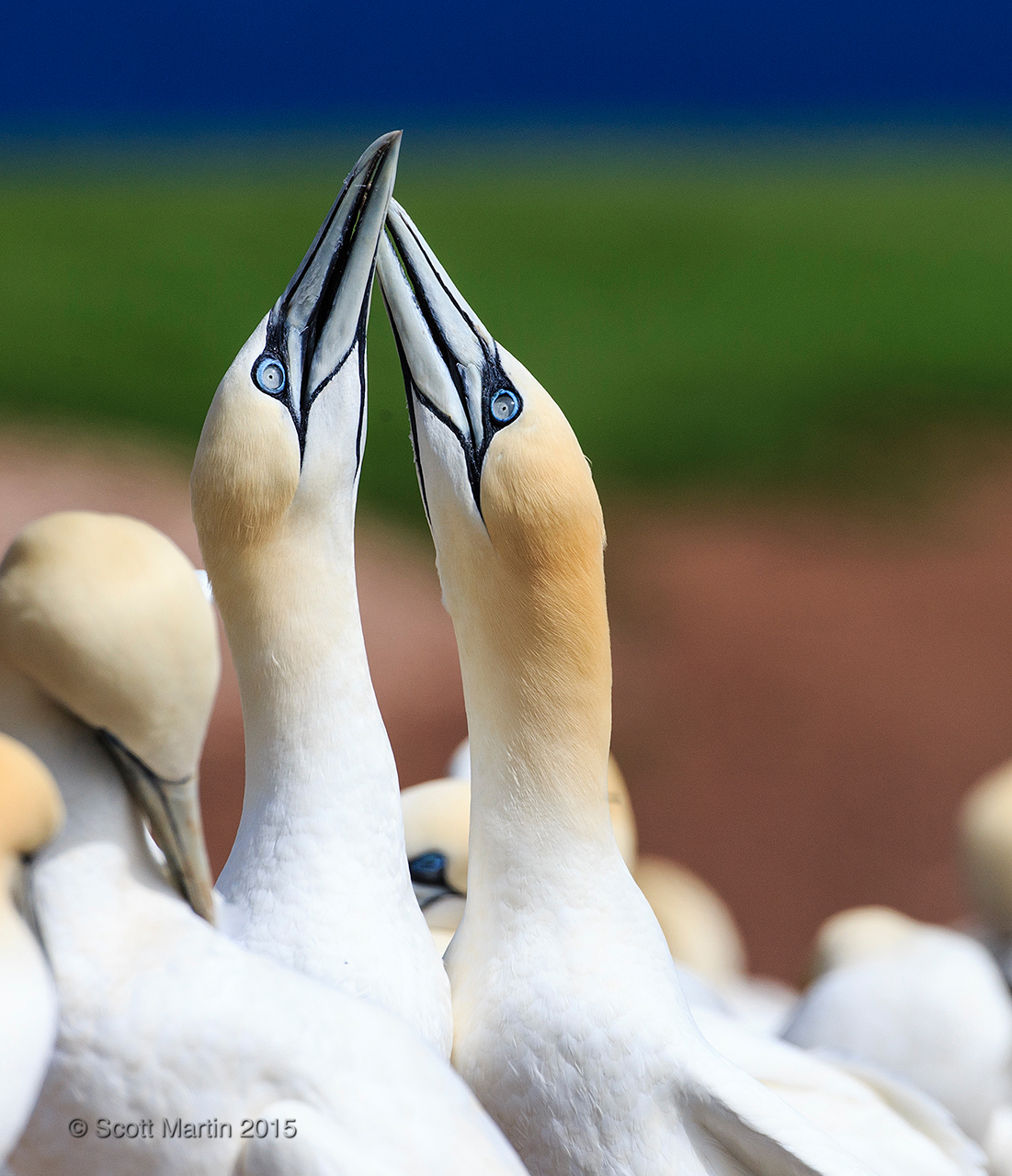 To capture fencing effectively, a low angle is required to separate the Gannets from the other birds and also create a clear back ground to enhance the photographic result.
To capture fencing effectively, a low angle is required to separate the Gannets from the other birds and also create a clear back ground to enhance the photographic result.
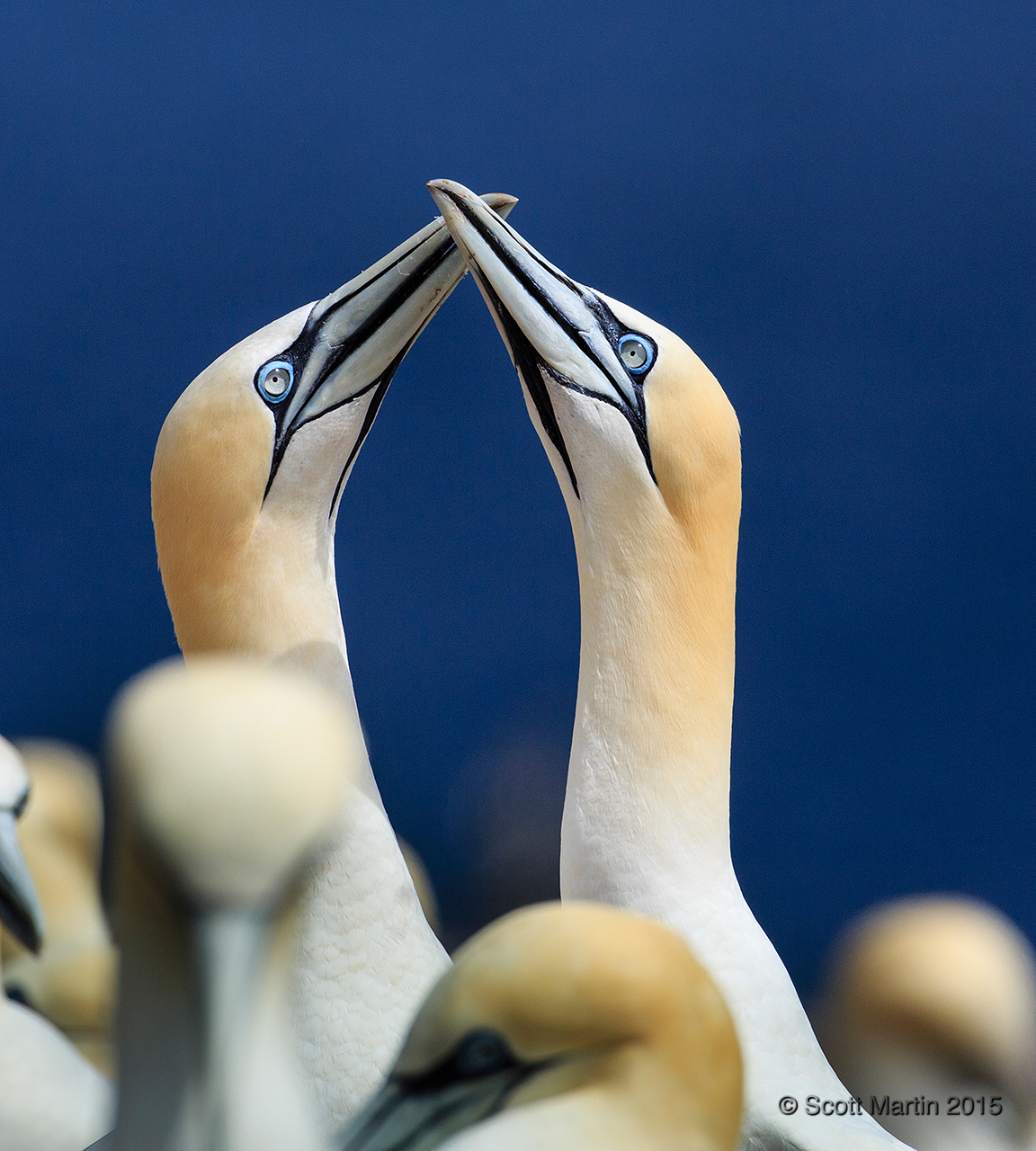
Yes, that means lying down in order to ‘get the shot’, but it’s always worth that extra effort!
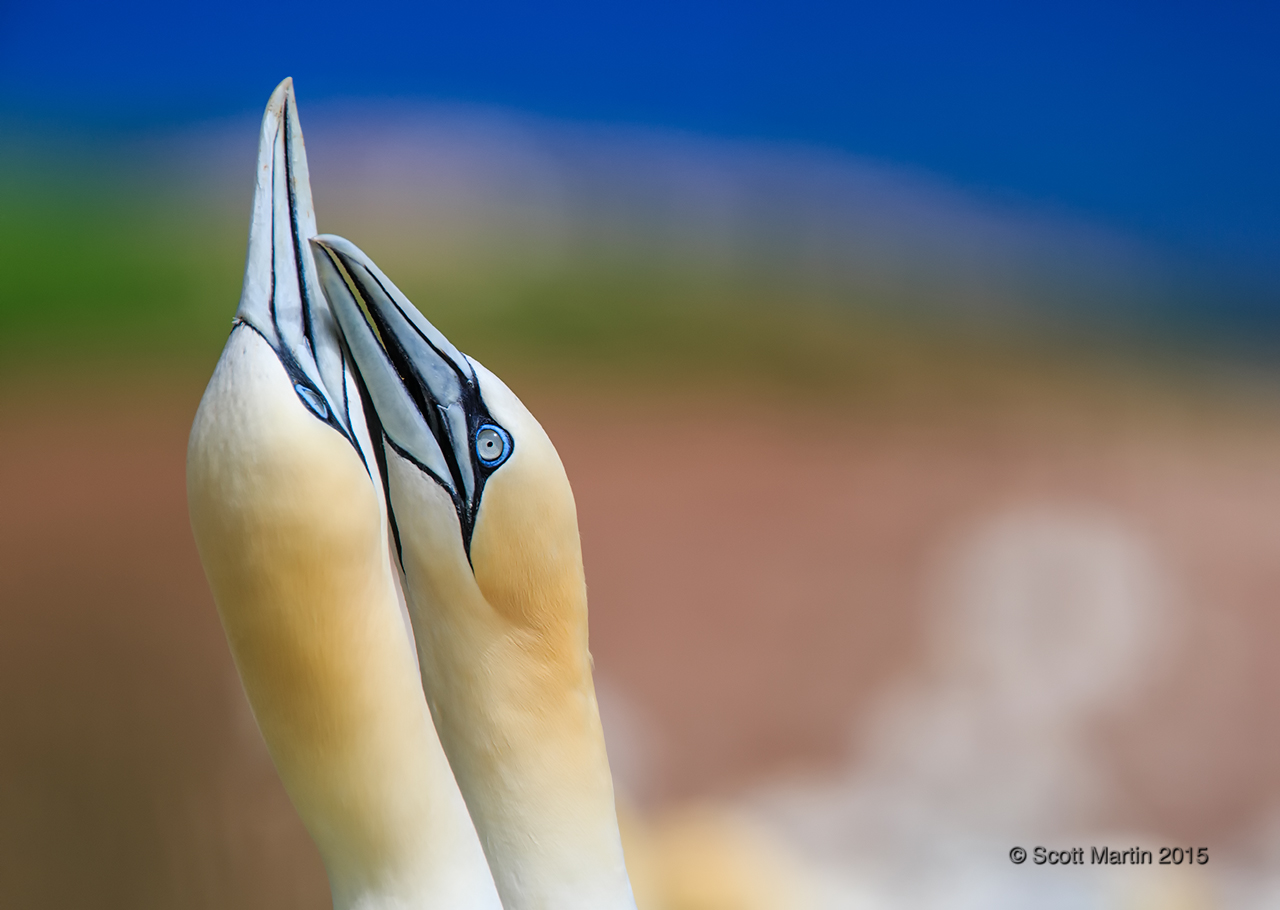
You can see and sense the affection these birds share with each other, which as monogamous couples they do for life.
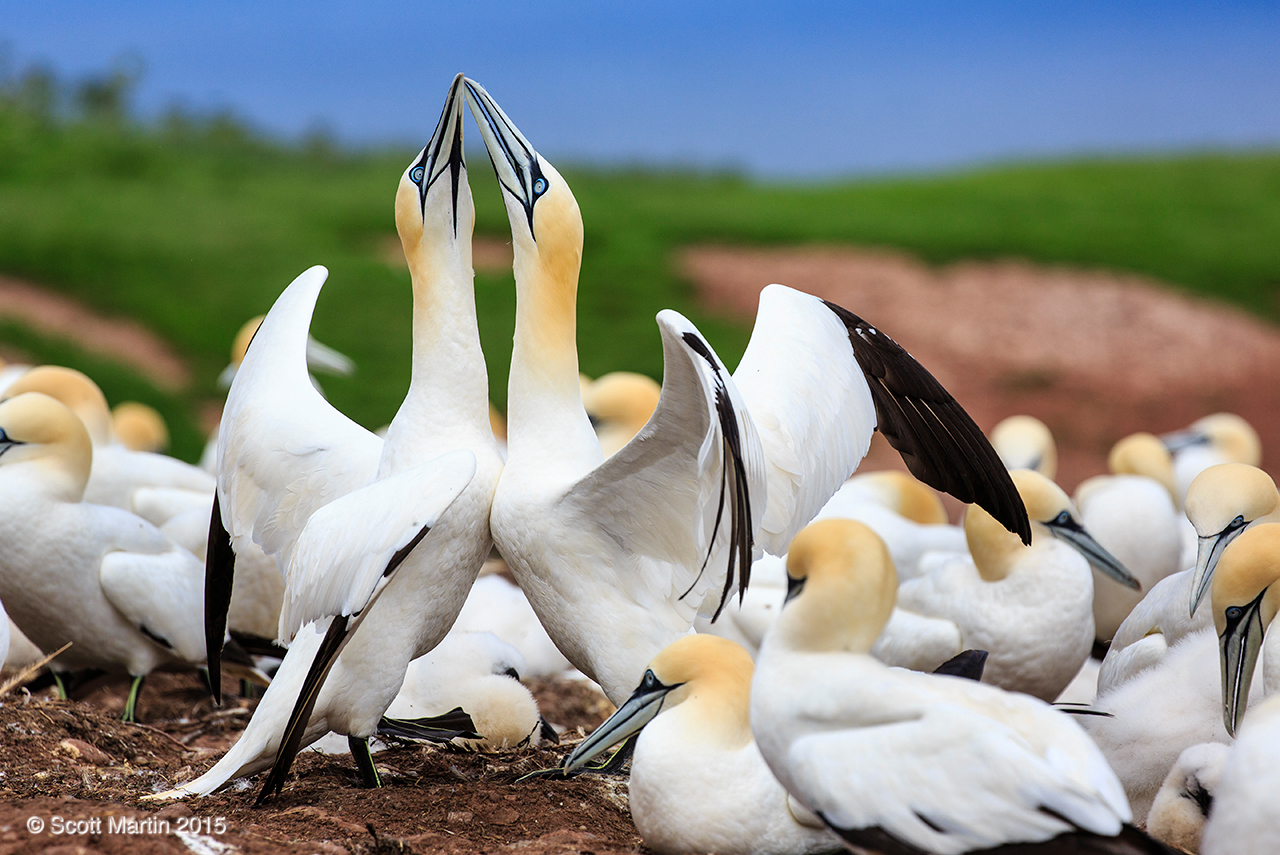
Although this next image lacks any eye contact (a bird photographer’s no no) it has become a favourite of mine with its artistic feel.
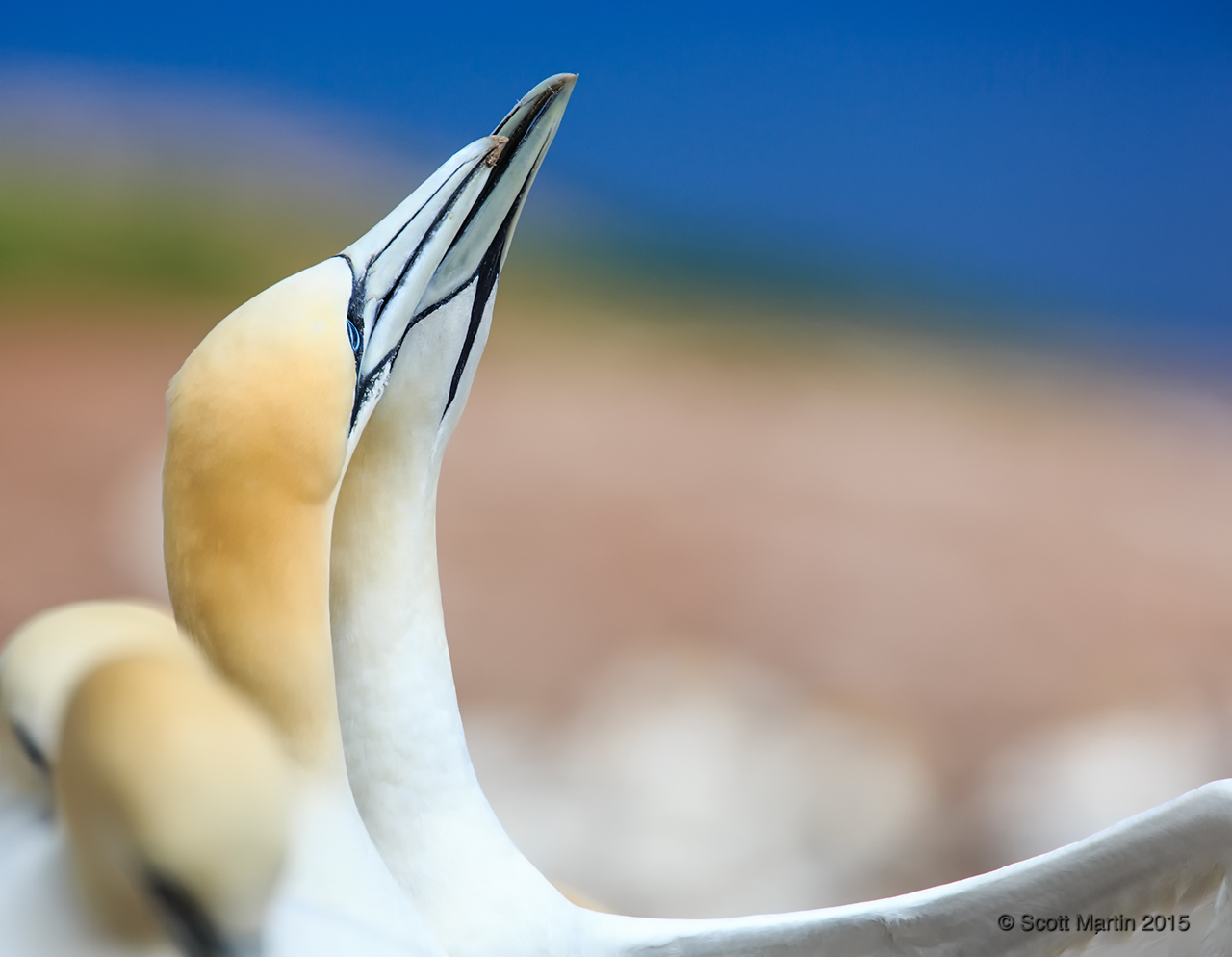
Mutual preening is another important mating ritual. The Gannet pair caresses and smooths the other’s feathers, typically around the head and neck.
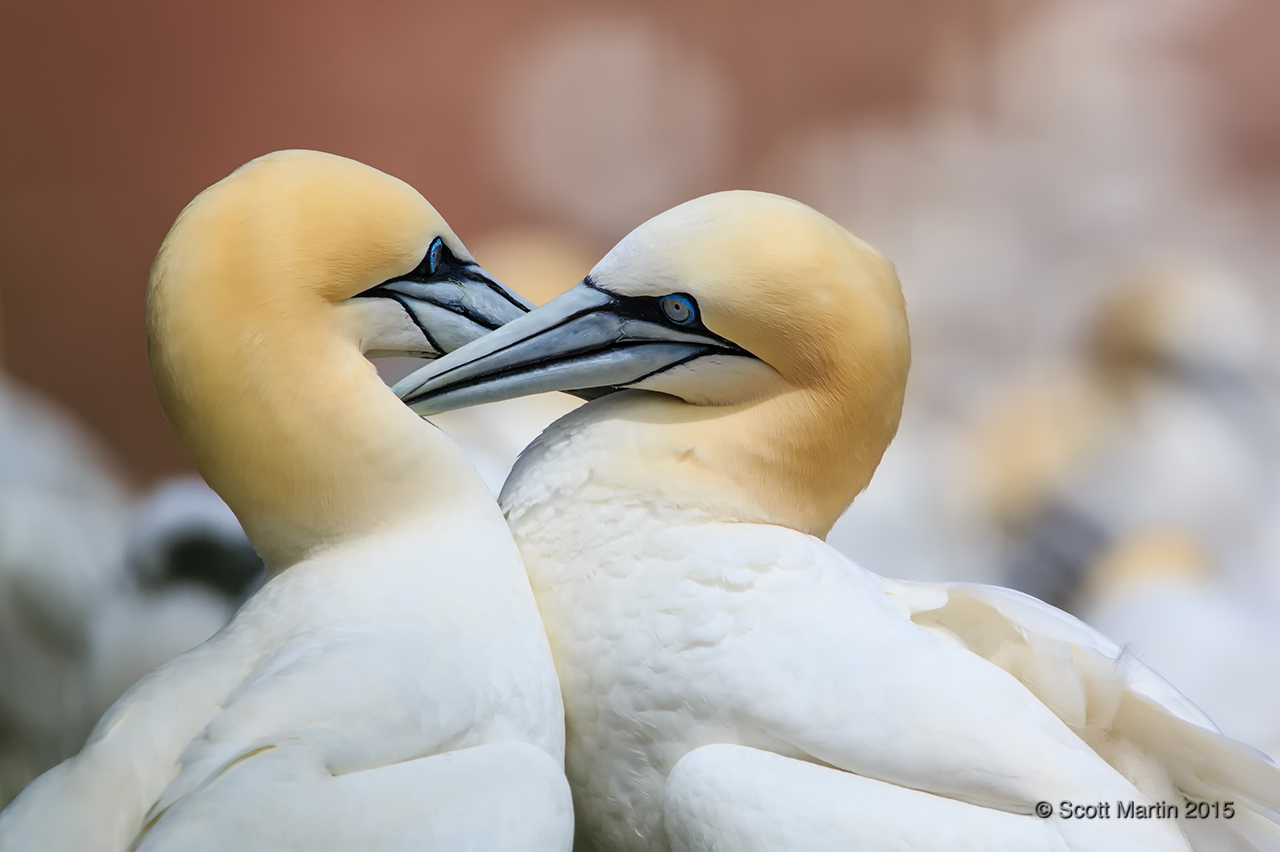
They will preen each other for extended periods of time.
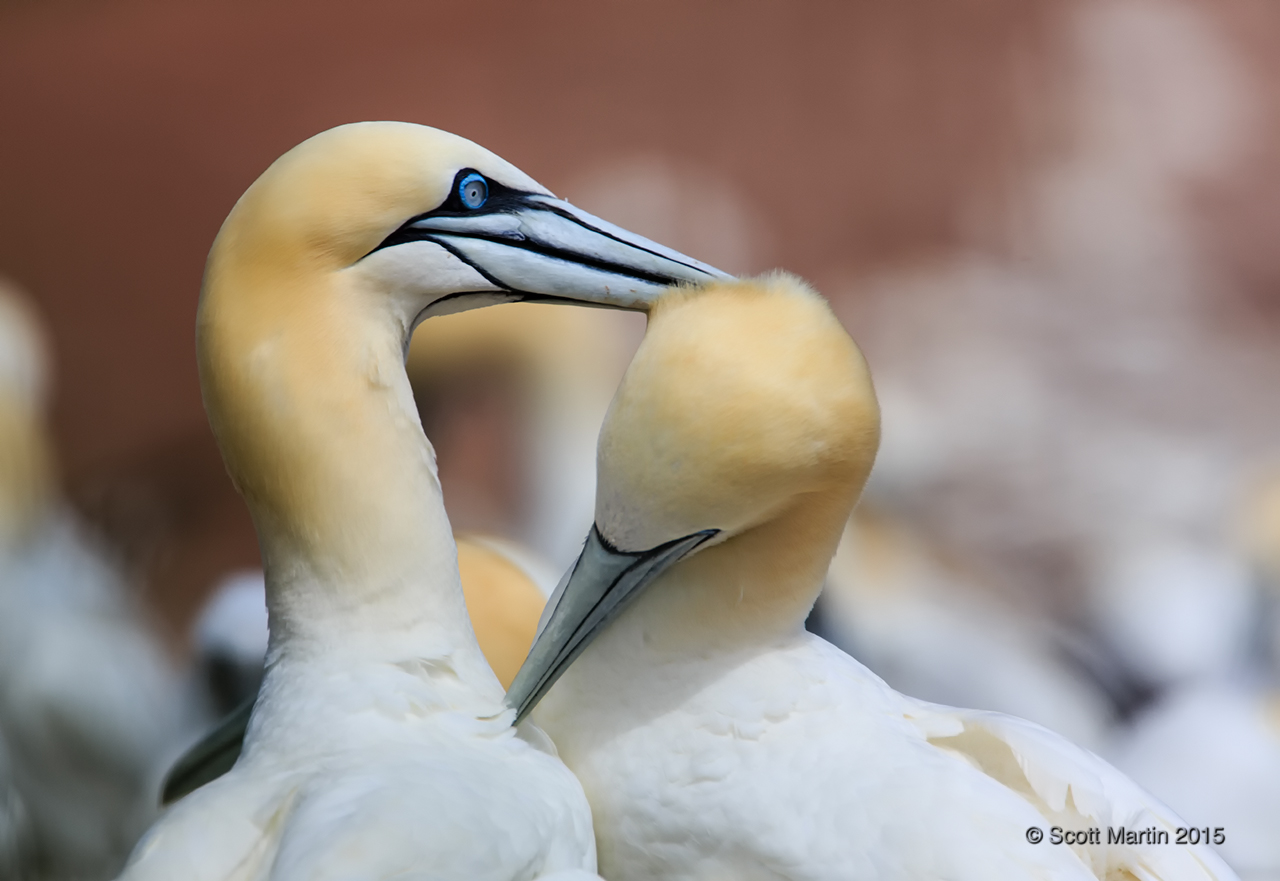 Unfortunately, fighting is common amongst Gannets, sometimes between pairs and more often with other Gannets that venture too close to a neighbouring nest. When fighting the birds anchor their claws into the ground and extend their necks to fight with their beaks. It often appears that they are attempting to jab the opponent’s eyes.
Unfortunately, fighting is common amongst Gannets, sometimes between pairs and more often with other Gannets that venture too close to a neighbouring nest. When fighting the birds anchor their claws into the ground and extend their necks to fight with their beaks. It often appears that they are attempting to jab the opponent’s eyes.
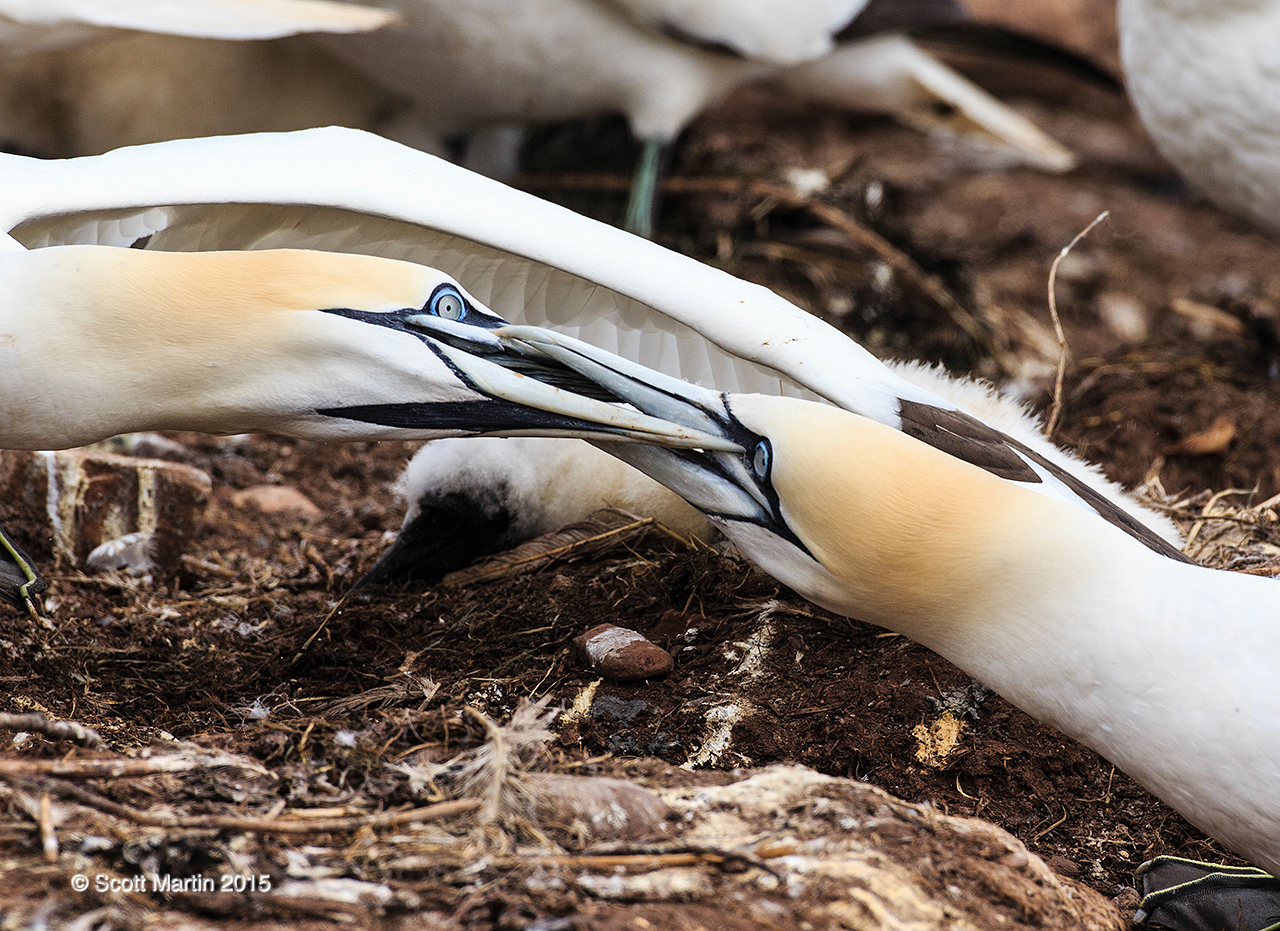
Threat-gaping, menacing and jabbing are related behaviours usually between Gannets on adjacent nests, where from a sitting position the birds jab towards each other while making lots of noise. There is generally no contact between the birds.
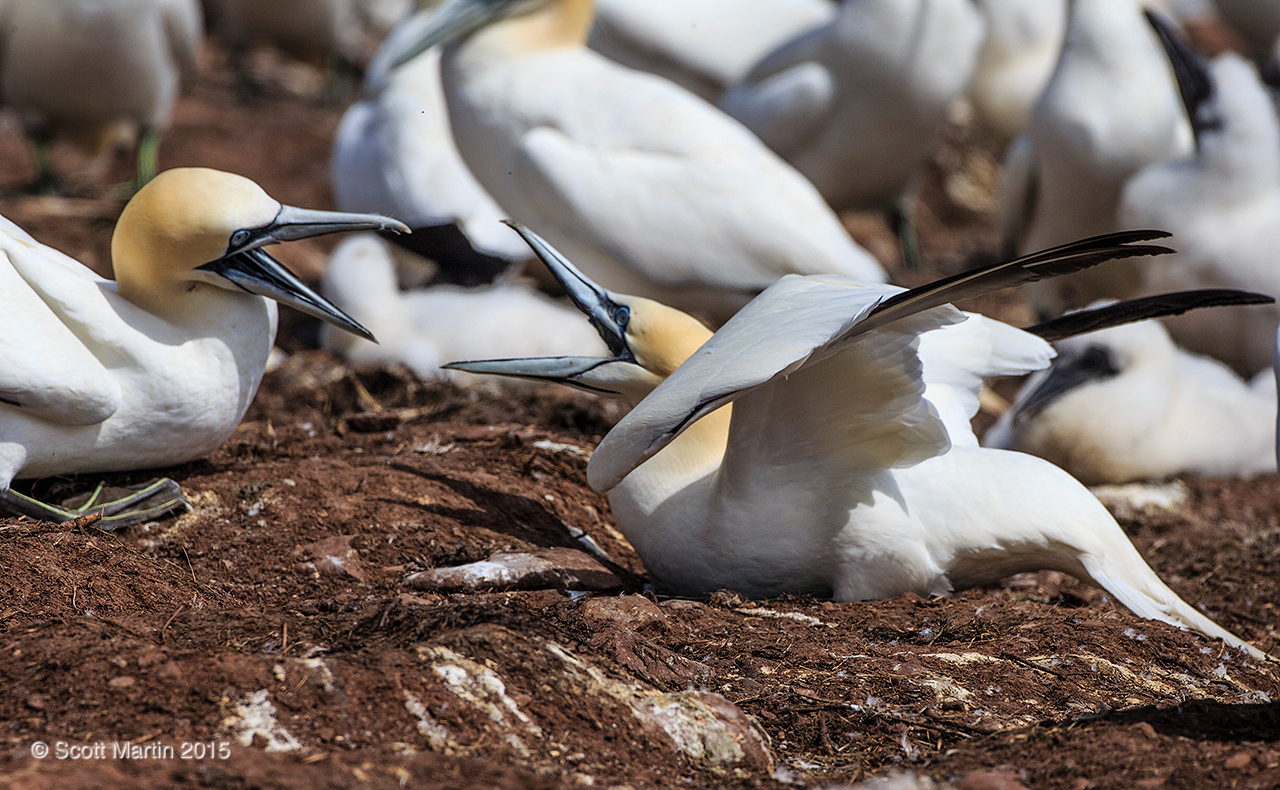
The last behaviour we will look at is called sky pointing and is thought to signal to a mate that the pointing partner is going to leave and the other is to stay and guard the nest. It is also performed by any Gannet in the colony who is about to take flight. When sky pointing, the neck is extended and bill pointed skyward, the wings are drawn back and the feet are prominently displayed with their bright green lines on black webbing.
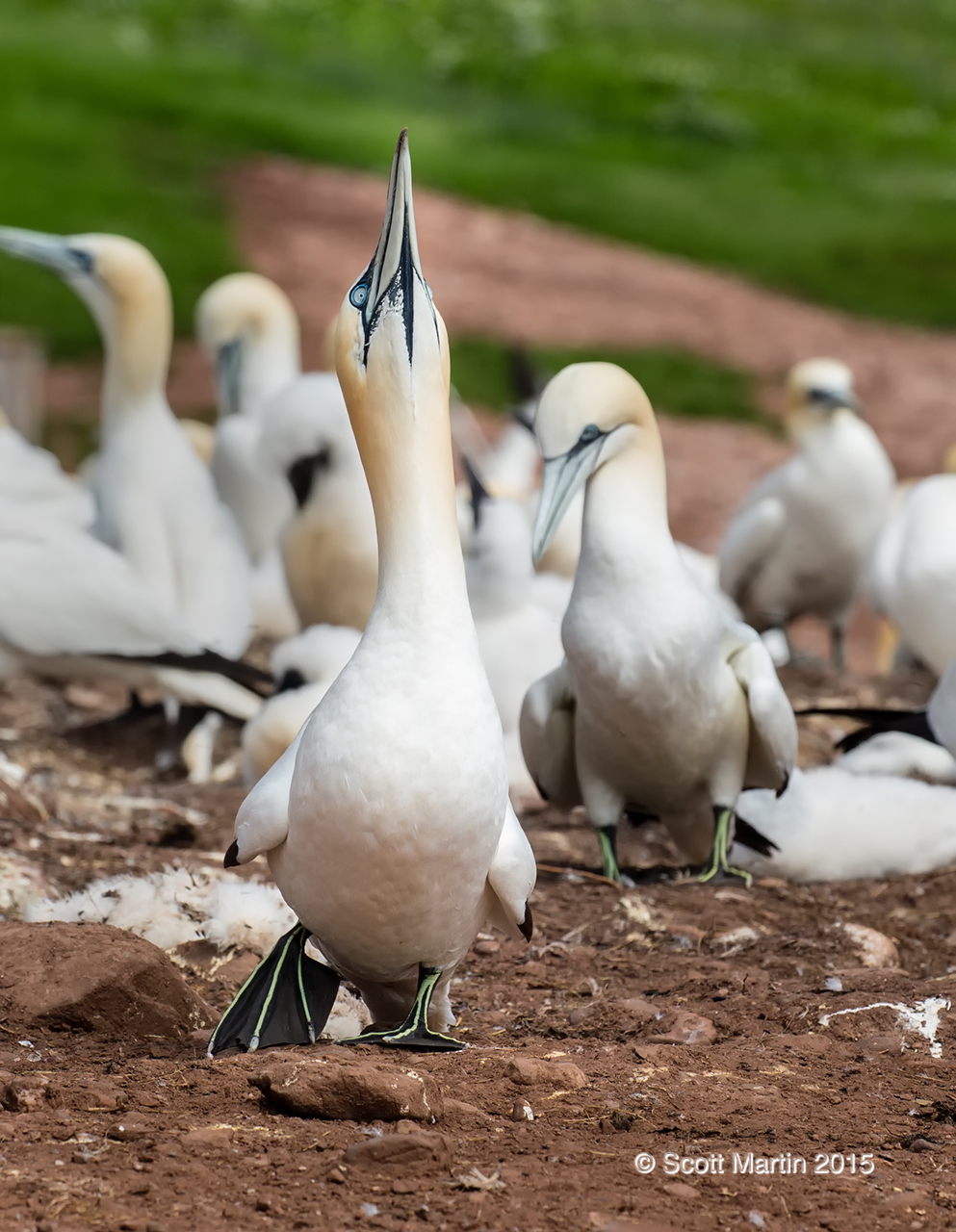
.
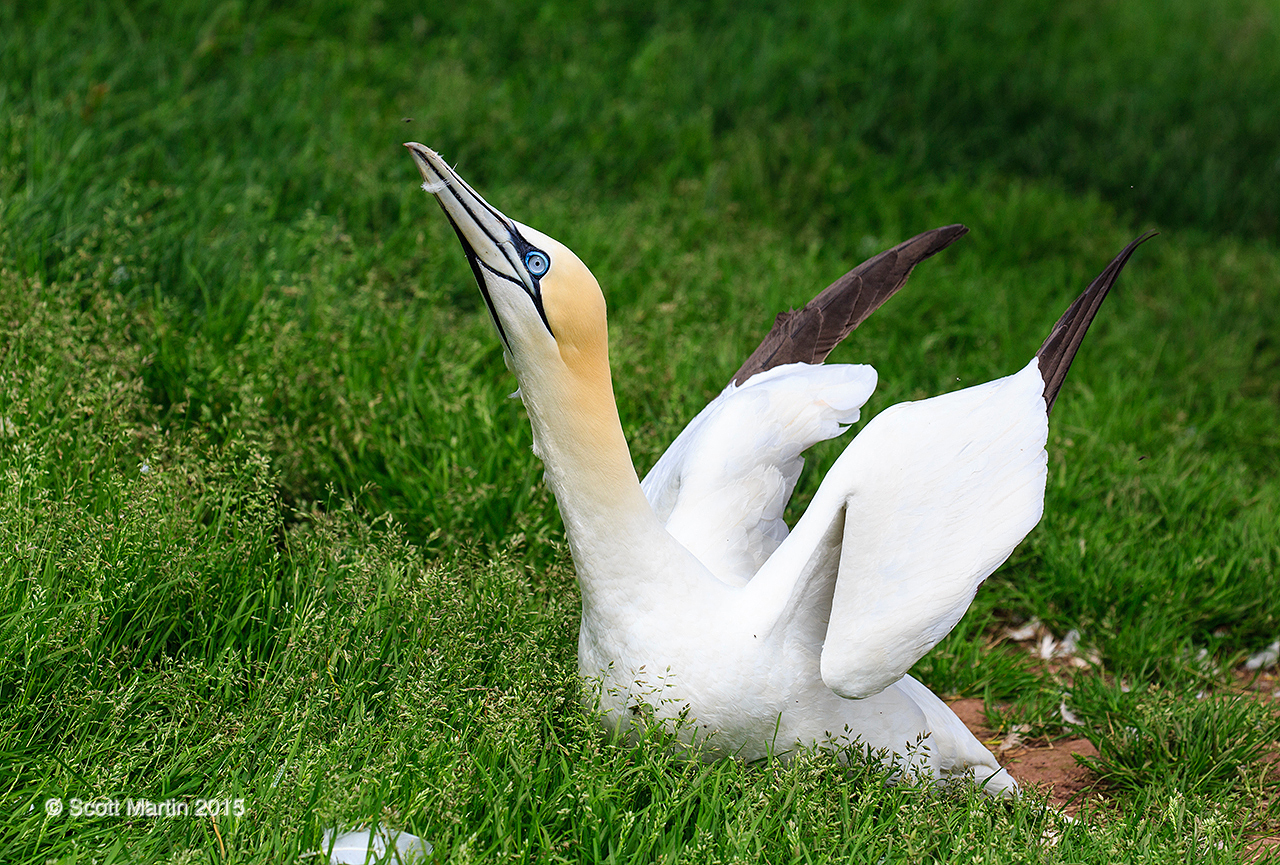
The Gannets of Bonaventure Island feed primarily on Mackerel, Herring and Capelin and they consume lots of them. It is estimated that each bird consumes 500 g of fish daily and that the annual fish consumption of the Bonaventure colony is 3,100 tons or 6.2 million pounds. It is fascinating to watch Gannets fish as they always do so in groups. Look-out birds scout the ocean for schools of fish and once found they must signal the others as large groups of Gannets quickly congregate overhead and then with pin point accuracy dive into the school of fish from impressive heights and at great speed. This style of group diving, sometimes described as hailstorm fishing causes panic and disorientation within the school of fish and it is thought that this greatly improves the Gannet’s success rate compared to fishing alone.
The following images show the classic diving sequence of the Northern Gannet. These images were taken from the pier in the town of Percé which is where the ferries leave for Bonaventure Island. The waters between Percé and Bonaventure are sheltered and thus are a prime fishing location for the Gannets.
A Gannet cruising high above the water spots a target, puts the brakes on and prepares to begin its dive.
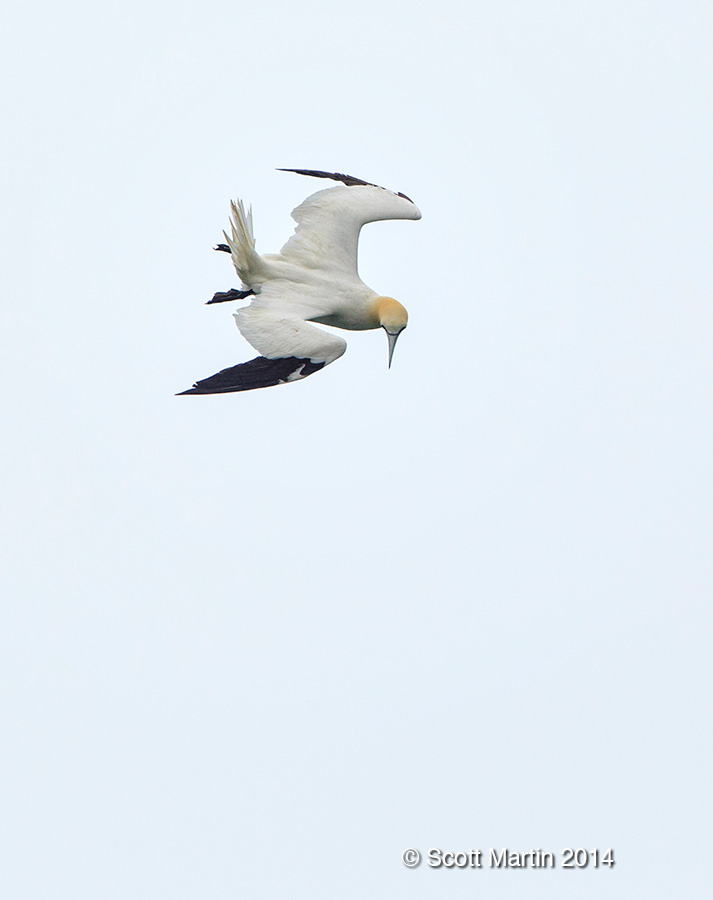
The dive begins with Bonaventure Island looming in the back ground
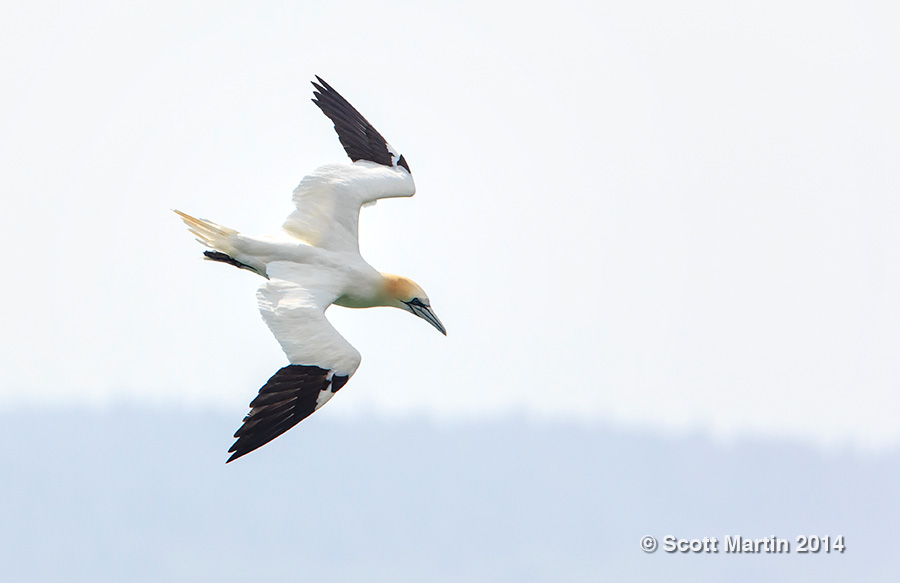
Gannets begin their dives approximately 100′ above the water and use their outstretched wings to steer them directly towards the target.
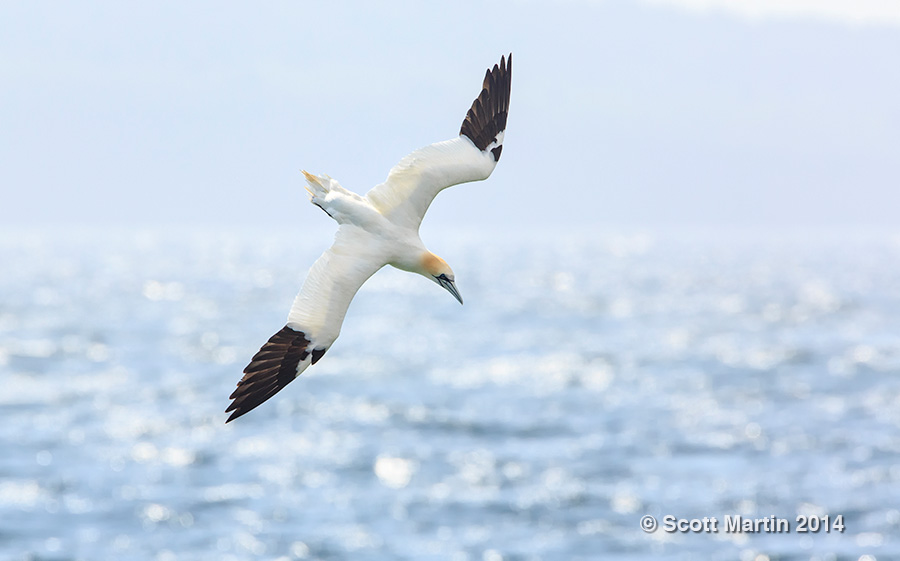
The wings remain fully extended until just before impact.
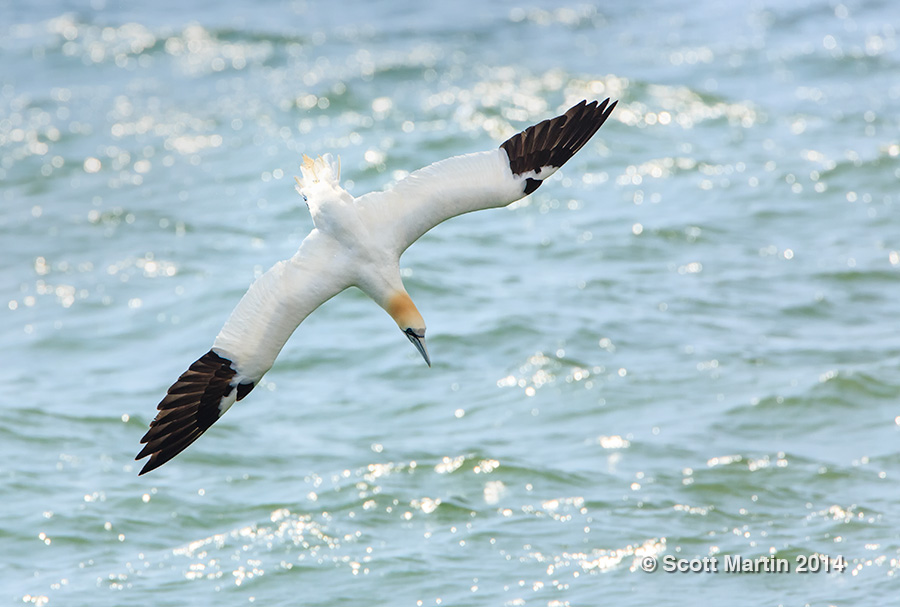
As they are about to enter the water they begin to quickly draw back their wings.
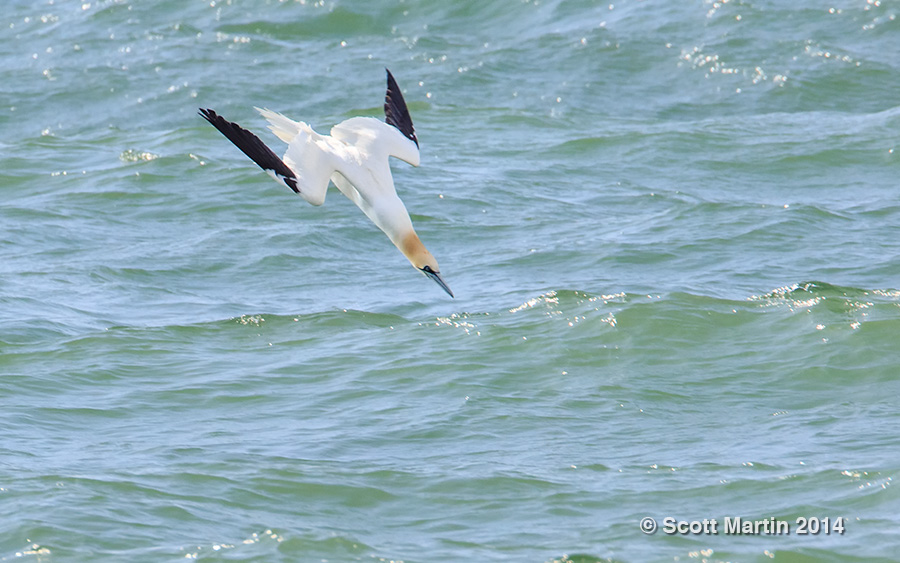
At the time of impact the wings are drawn fully back and neck is extended and the Gannet looks more like a torpedo that the very large pelagic bird it is.
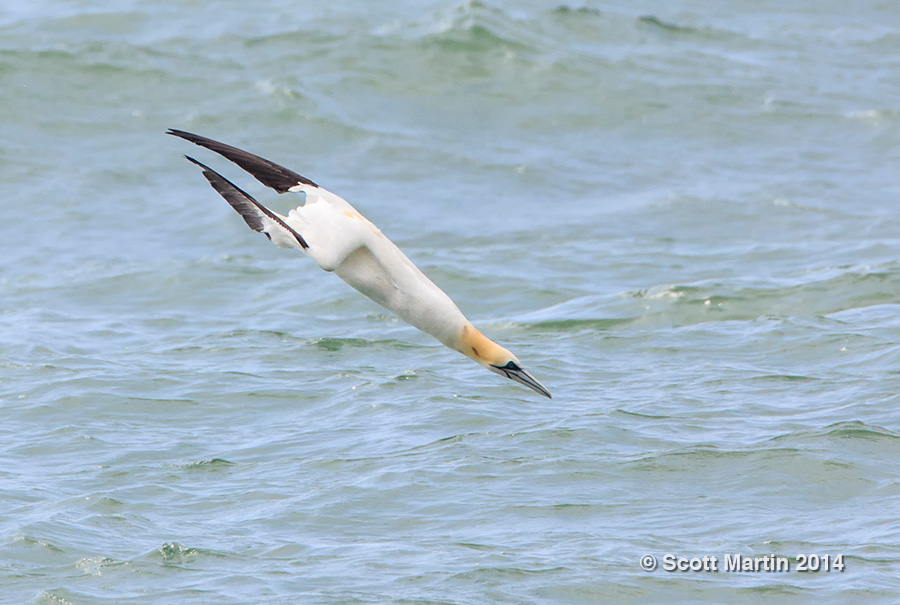
The speed of the Gannet at impact with the water is 100 km/h and even at that speed, the large size and buoyancy of the bird only allows it to reach depths of five or six feet. They catch their prey while returning to the surface.
As we conclude this post I will leave you with some portraits and in flight images of the Northern Gannet. I trust these help give you an appreciation for this great bird of Bonaventure Island.
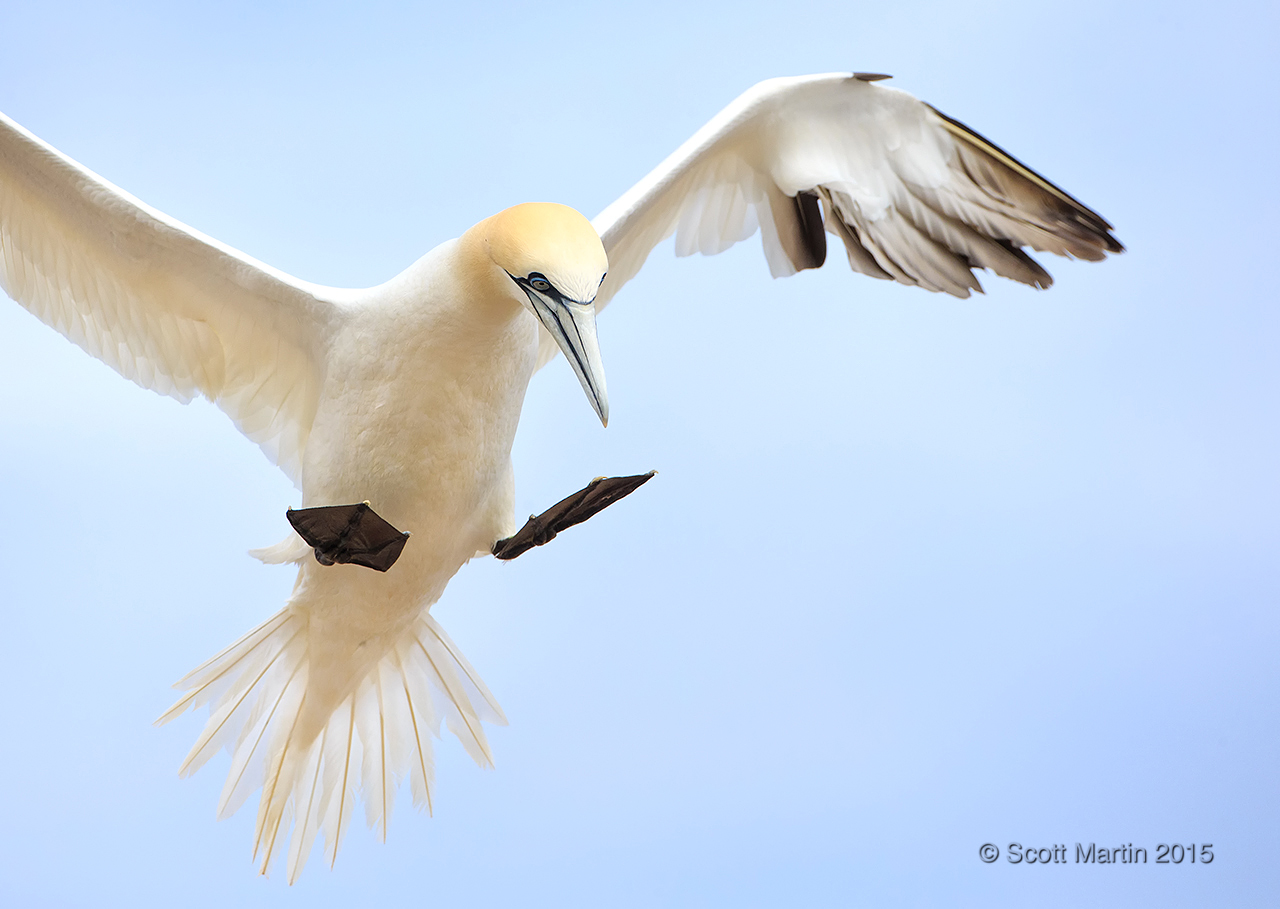
When given the opportunity, attempt to photograph birds against different back grounds which greatly influences the photographic results. The photo above has the sky as the background while the image below uses the water.
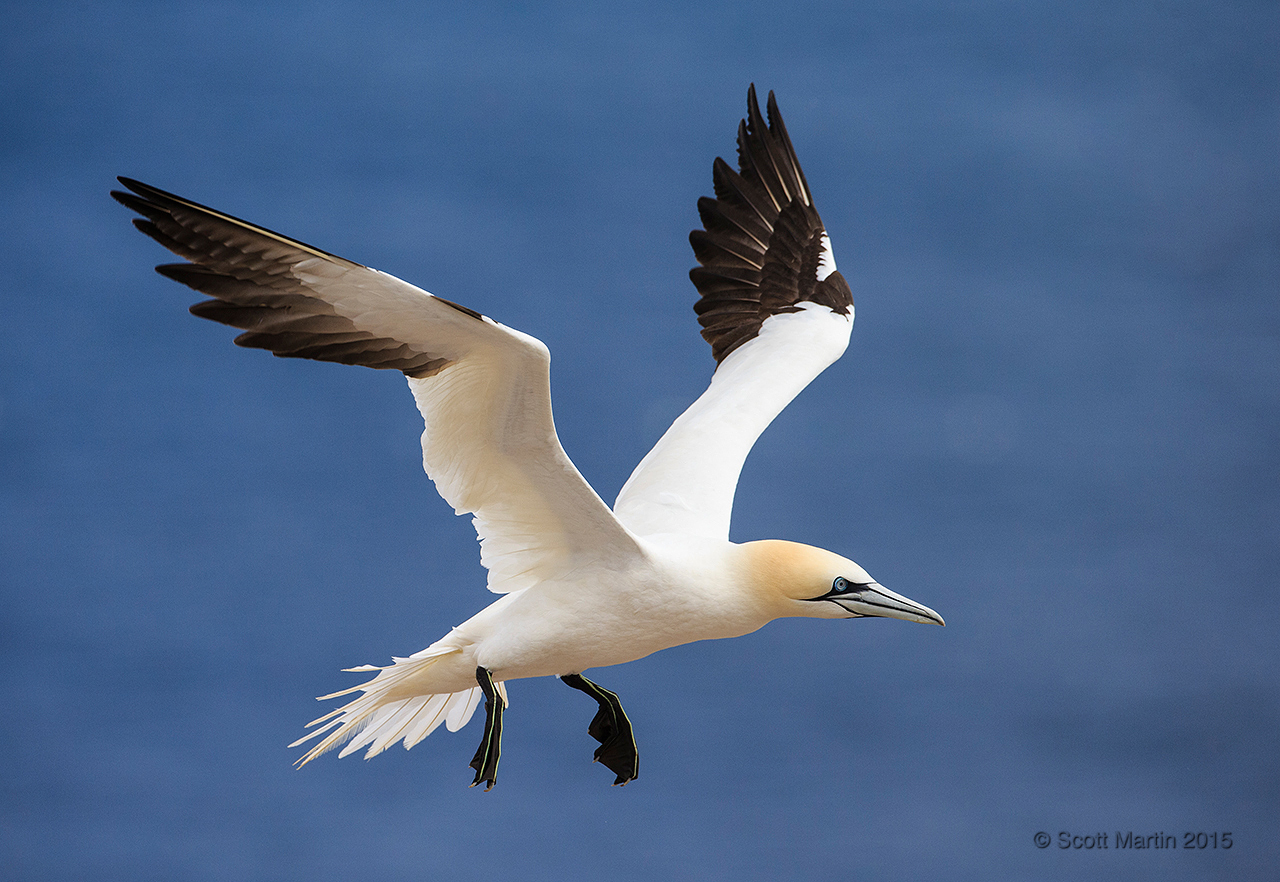
A unique pose with both eyes visible. Not a common occurrence in bird photography.
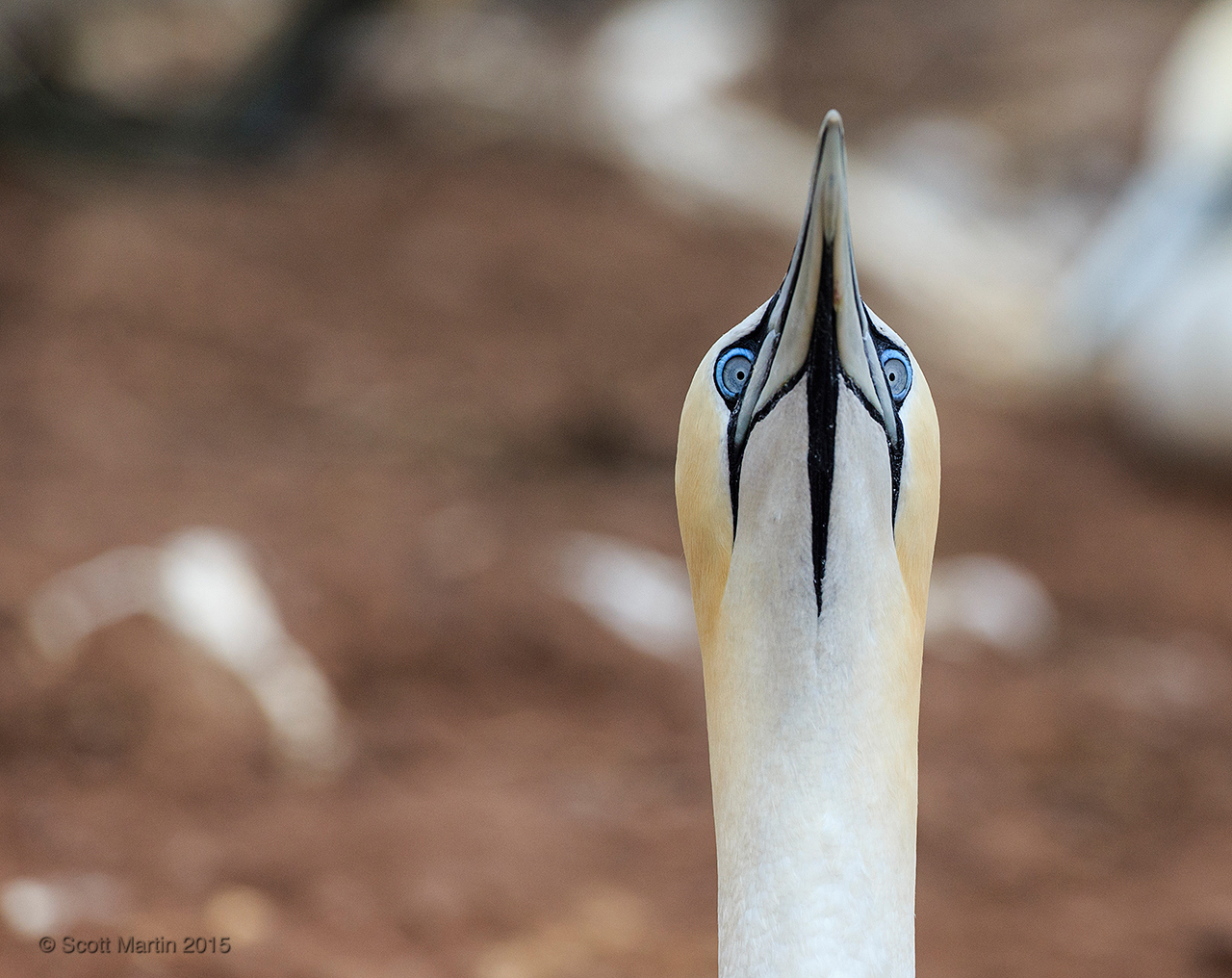
The long and slender wings of the Gannet make it ideally designed for gliding and riding the thermals that move up the cliffs on which they nest. This also allows the large and heavy Gannet to cover large distances with minimal effort.
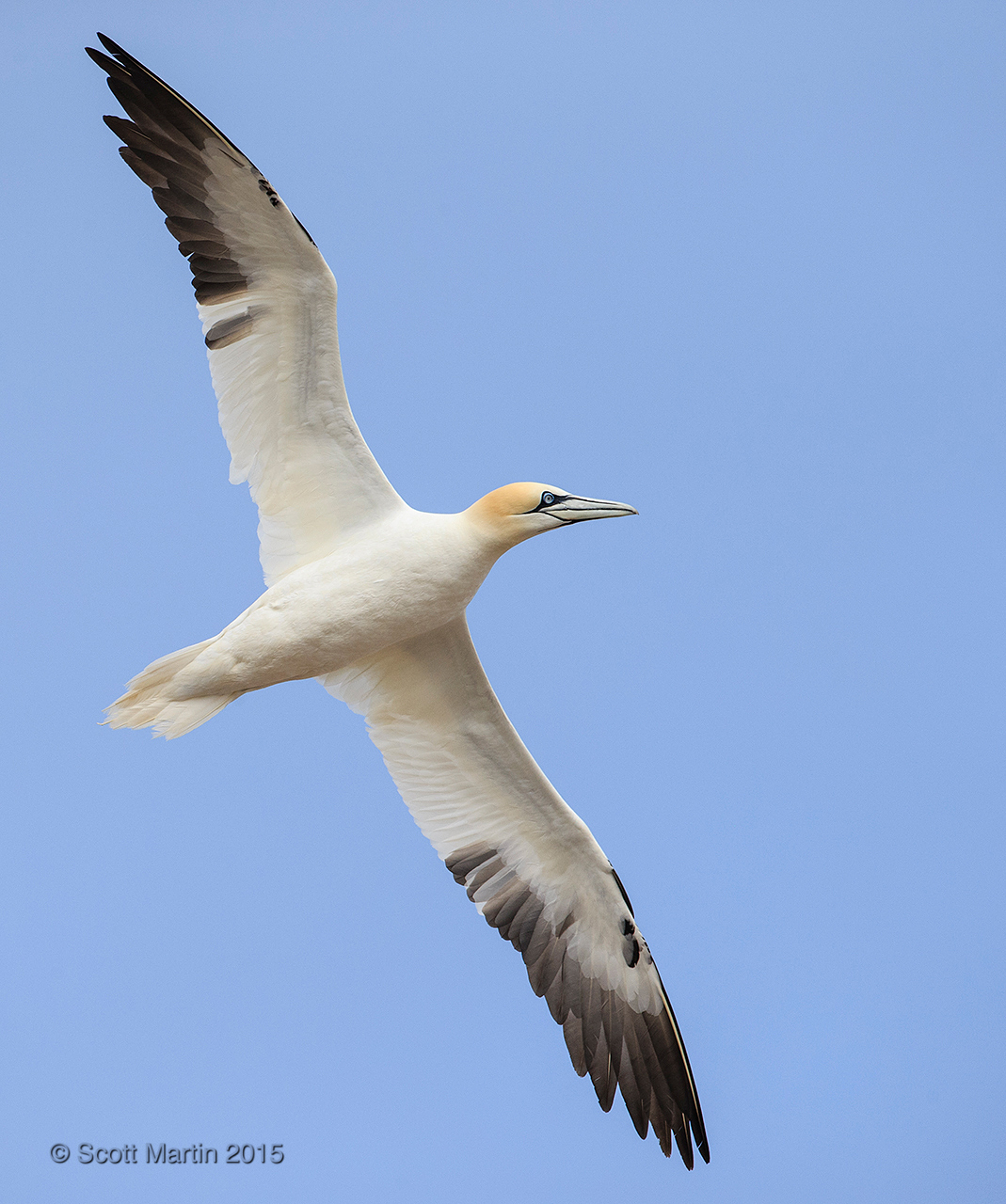
A Gannet slowing down after spotting its nest location.
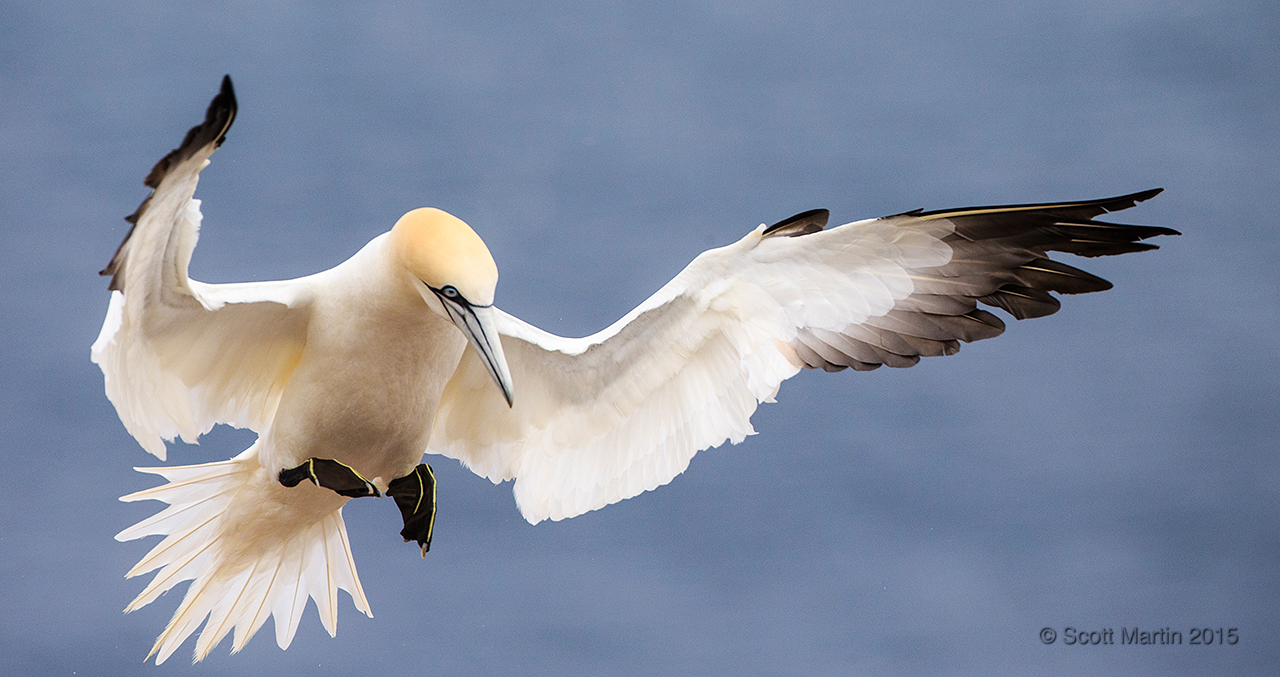
Capturing two birds in flight in the same frame with both in focus is a difficult challenge but the perseverance required paid off….eventually!
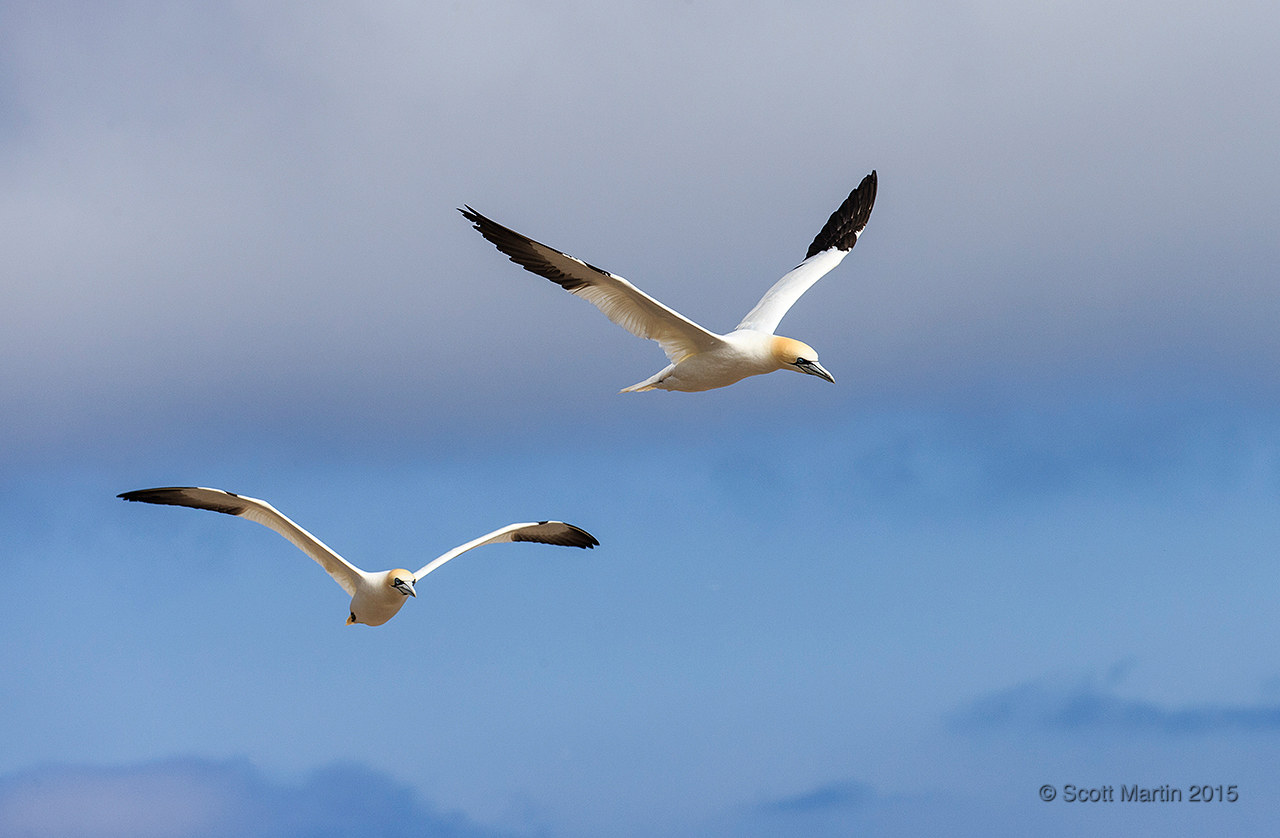
They truly are a photogenic species.
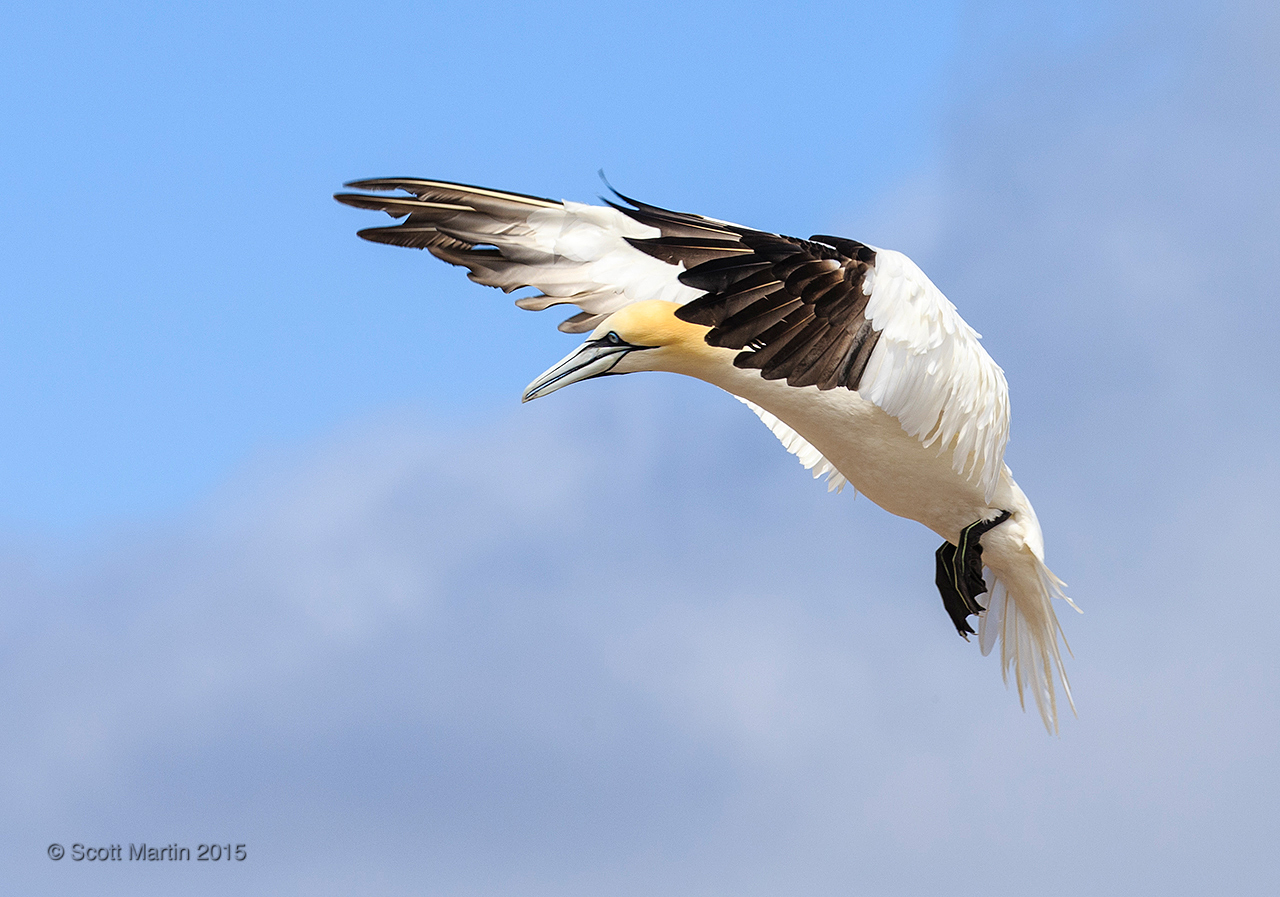
A Gannet cruising low over the colony before heading out to fish.
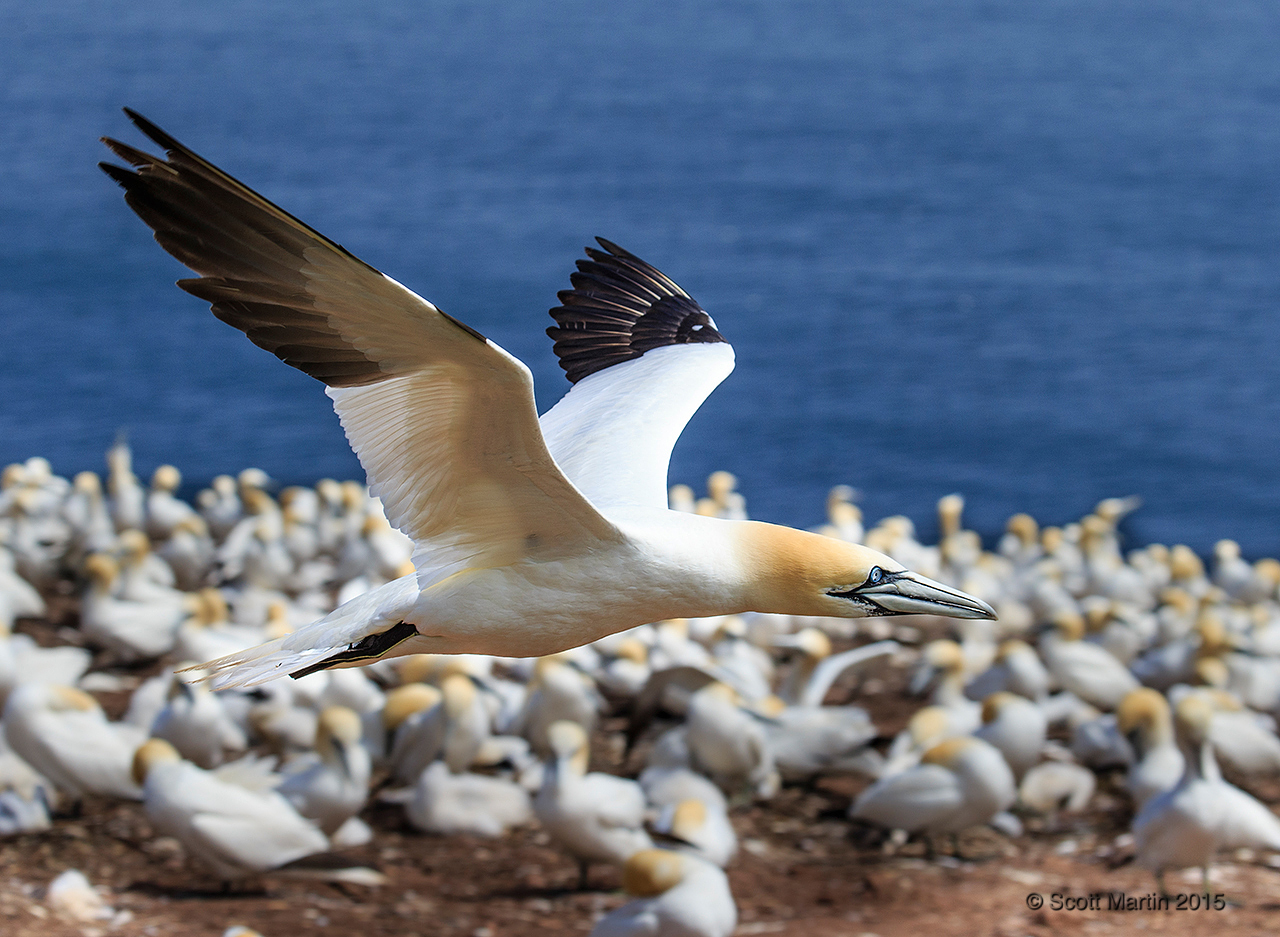
An in flight acrobat, slowing down and looking for the nest.
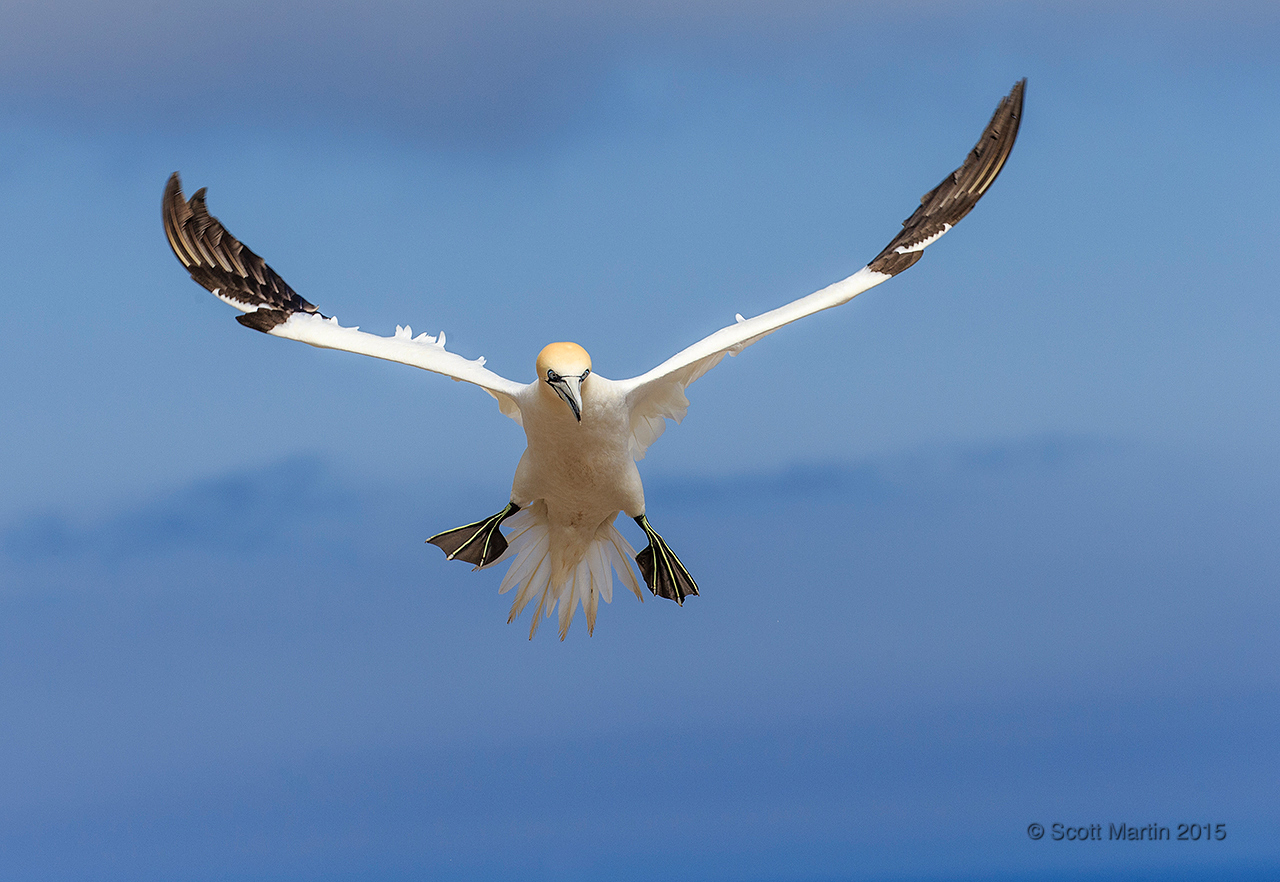
An affectionate couple guarding their nest.
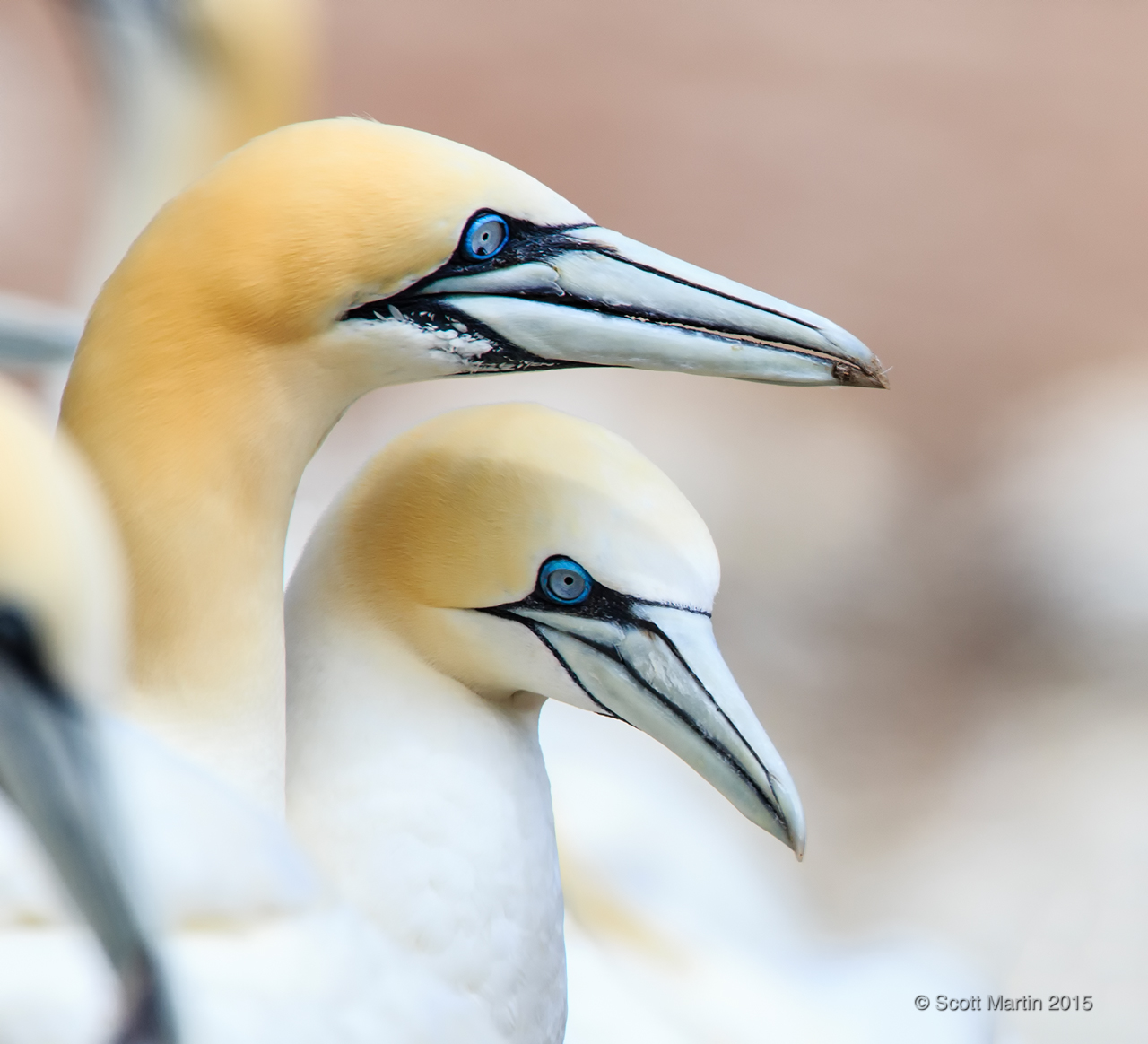
Gannets normally dwell on cliffs but when there is no real estate left on the cliffs they occupy the plateaus atop the cliffs. They quickly denude the plateaus of vegetation and don’t often stray into grassy areas except to gather nesting material, or to offer the gift of grass to a potential partner, as an offer to build a nest together. It was a treat to find this Gannet with grass in its beak.
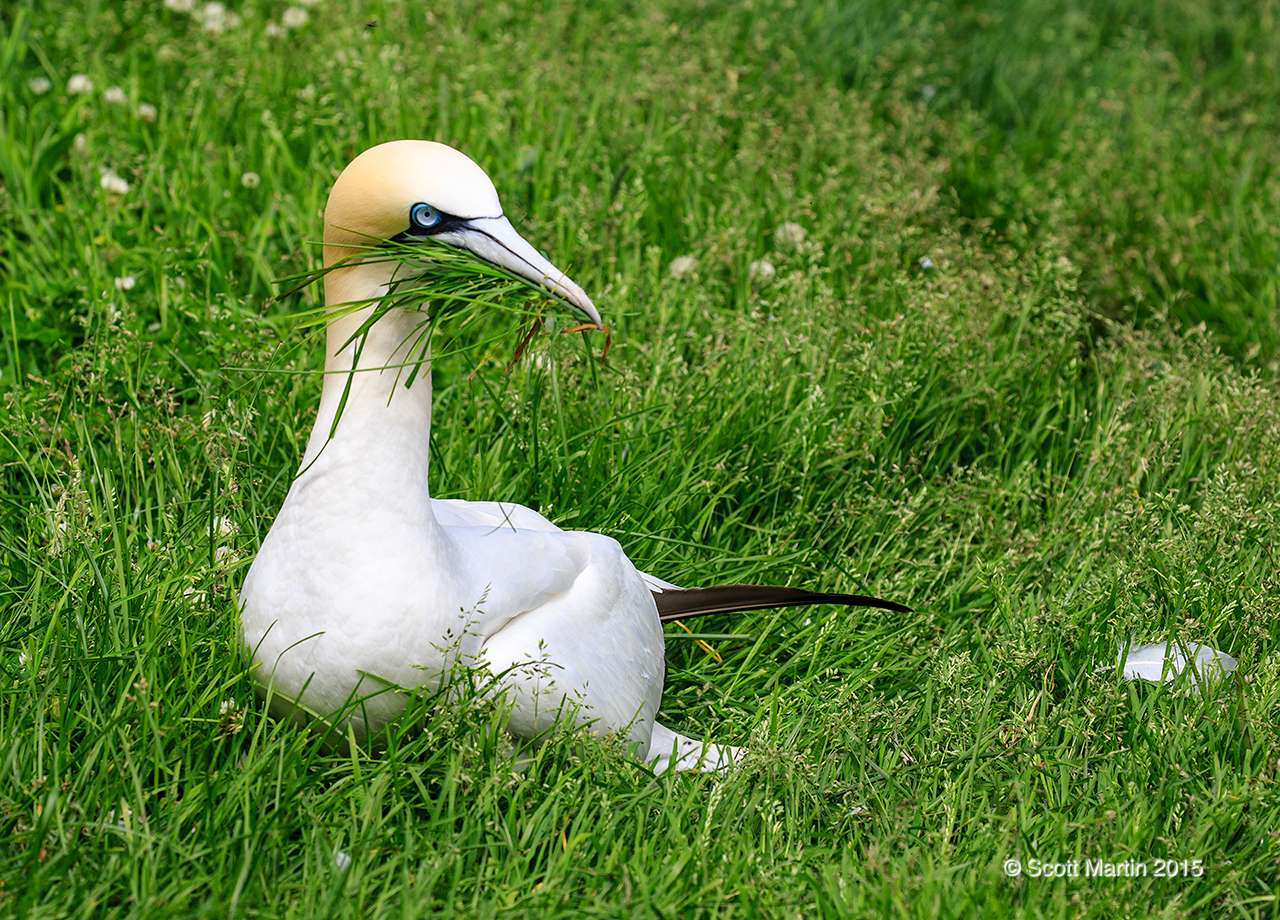
Apparently the object of his desire wasn’t overly interested in his kind offer!
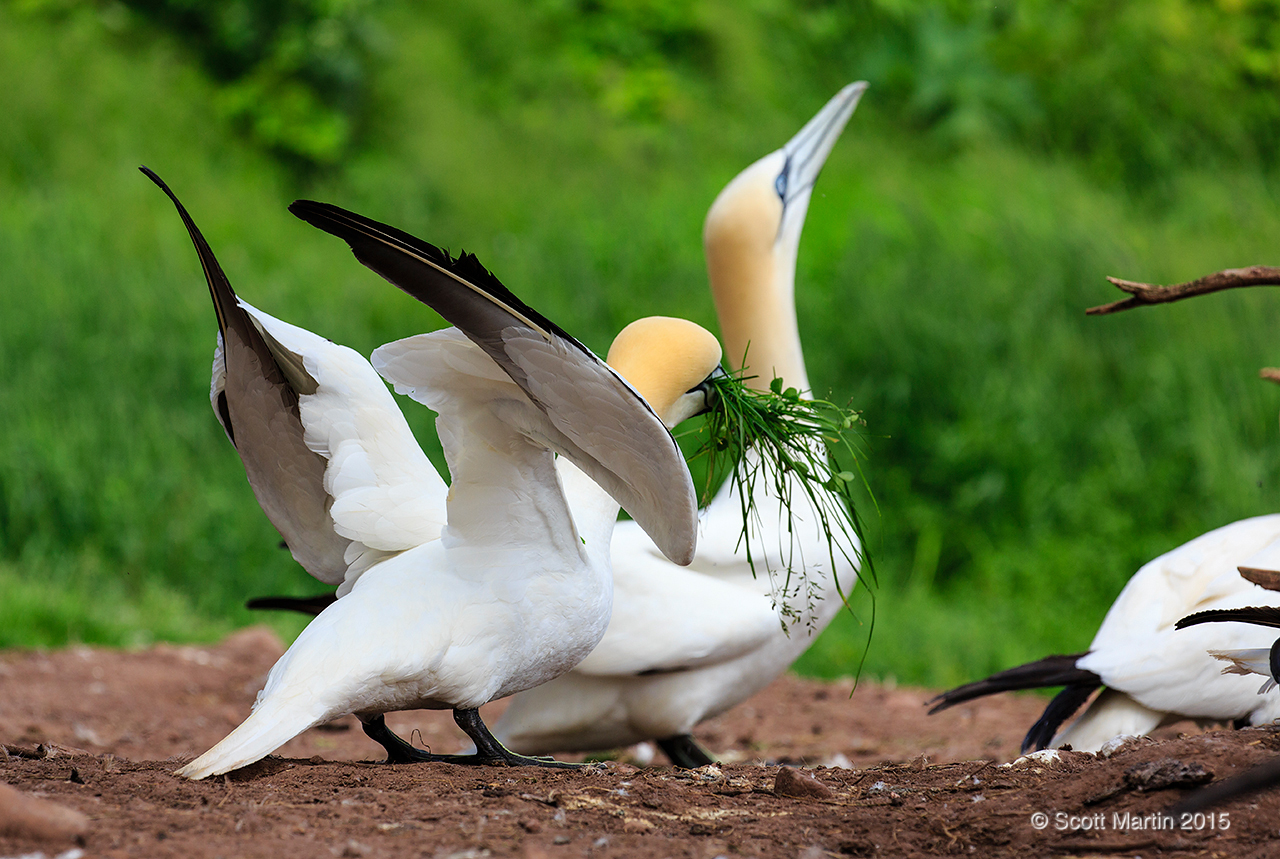
The maestro pose against a natural gradient background.
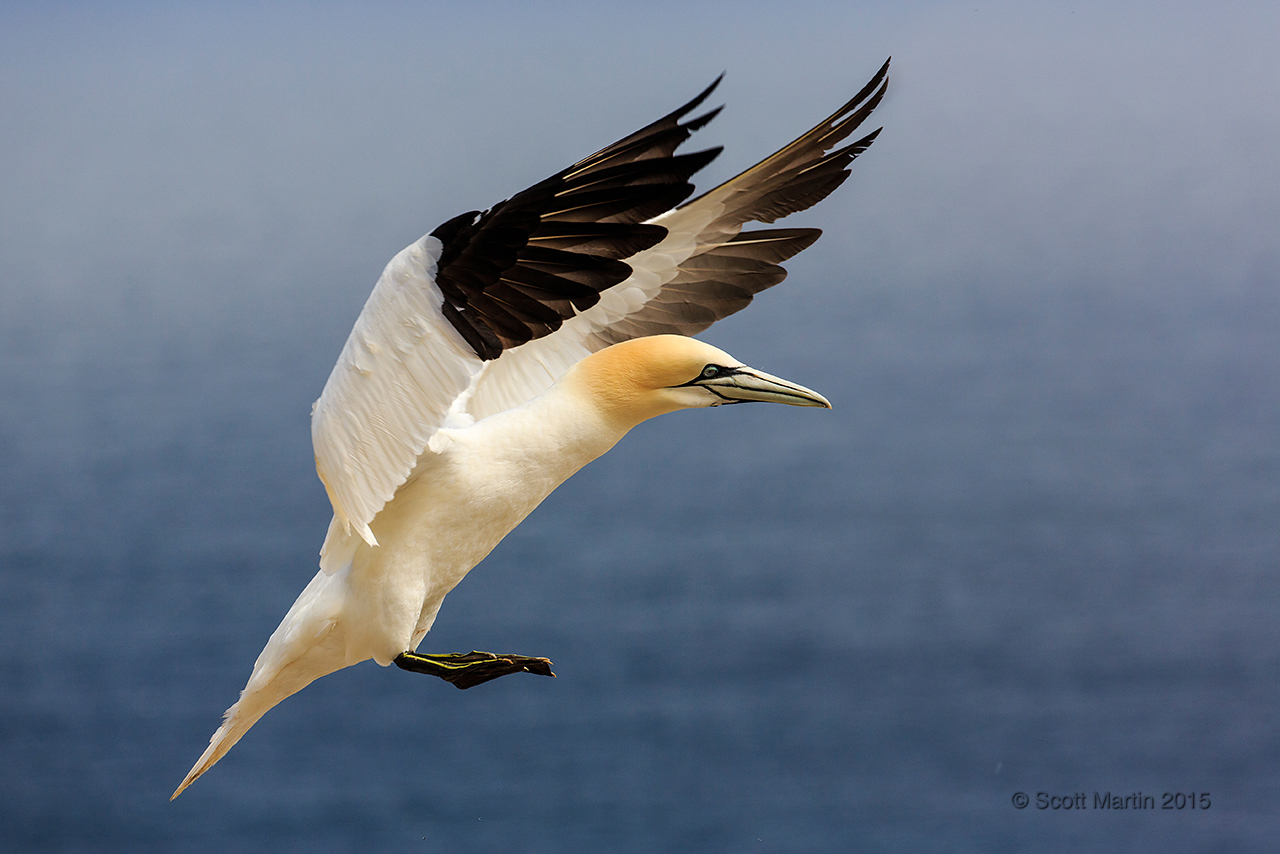
And a final tight portrait of the Northern Gannet with its steel eye and intense blue eye ring.
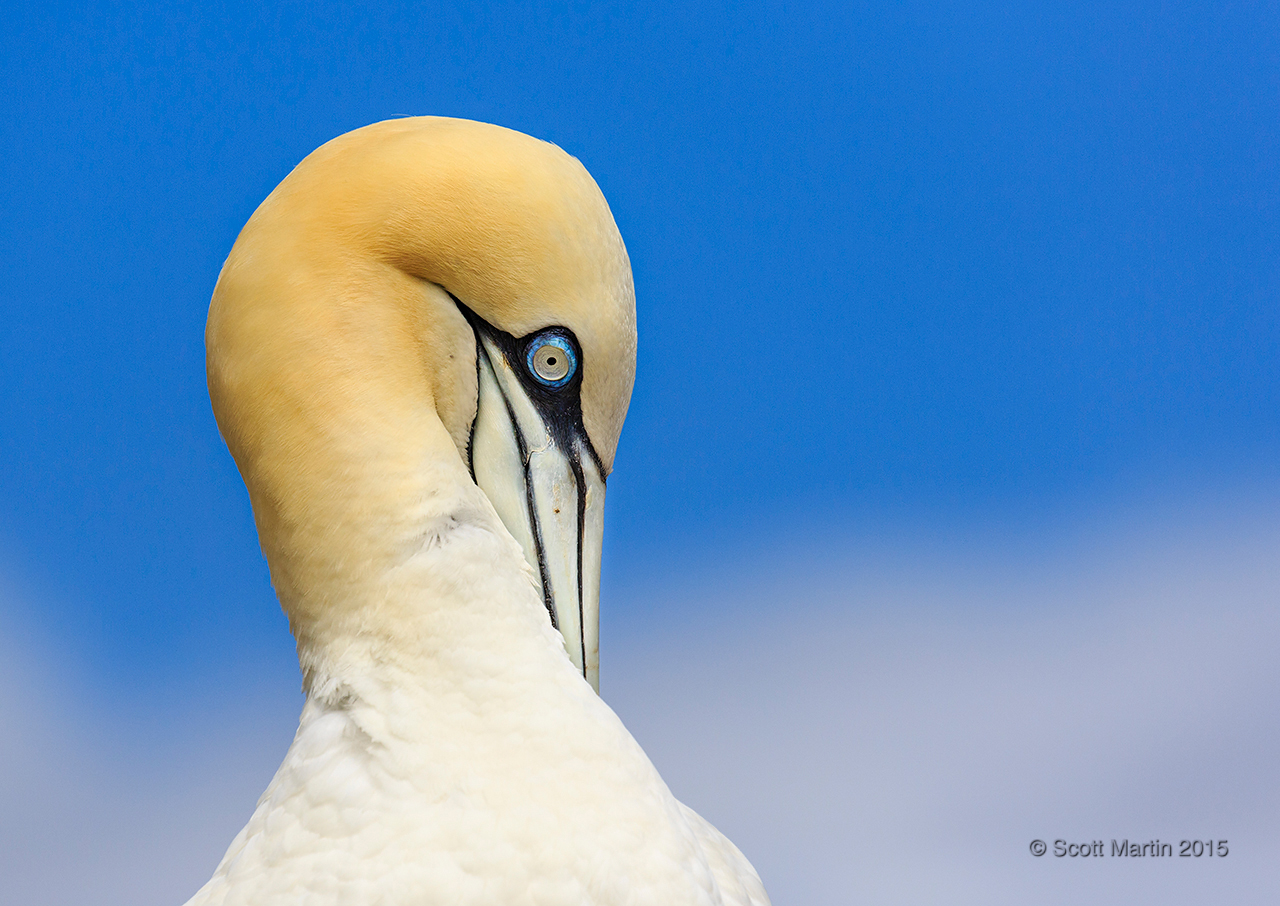
Although this post contains a number of images, there are many more in the Gulls, Gannets, Terns & Skimmers Gallery. I trust you will enjoy them as well.
Deb and I have had the opportunity to visit Percé and Bonaventure Island each of the past two summers to photograph Northern Gannets. We both highly recommend that you make the effort to travel to the Gaspé Peninsula of Quebec, not only to see the Gannets but to explore this very unique and beautiful part of our great country. You won’t be disappointed. If you want any Gaspé travel tips don’t hesitate to contact me as I’d be glad to help!


I have been anticipating this post for some time and I must say it was well worth the wait. I expect that I will be making the trip to Bonaventure Island and your most informative post gives me plenty to contemplate plus these exquisite images set the bar pretty high 😉.
Thanks Arni and you will certainly enjoy a day on Bonaventure Island with the Gannets. Plus the Gaspé Peninsula is a spectacular part of Canada.
Scott, thanks for an extremely interesting, informative and amazingly illustrated blog. I can’t imagine how you managed to photograph the gannets in so many different activities! You accomplished a lot in the relatively short time you were on the island.
Thanks Dad. It was fascinating watching all of their interesting behaviours and fortunately we were able to capture most of them!